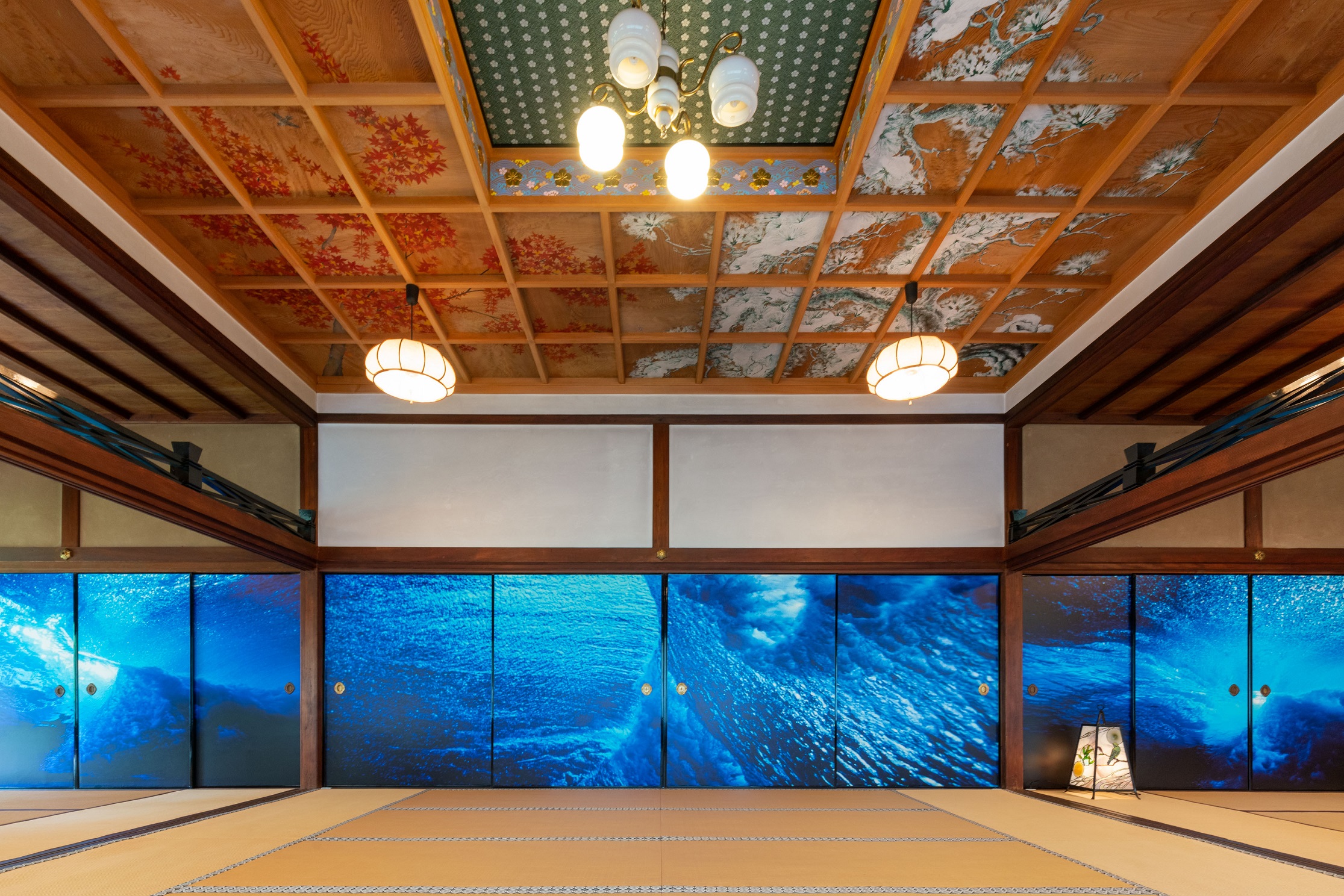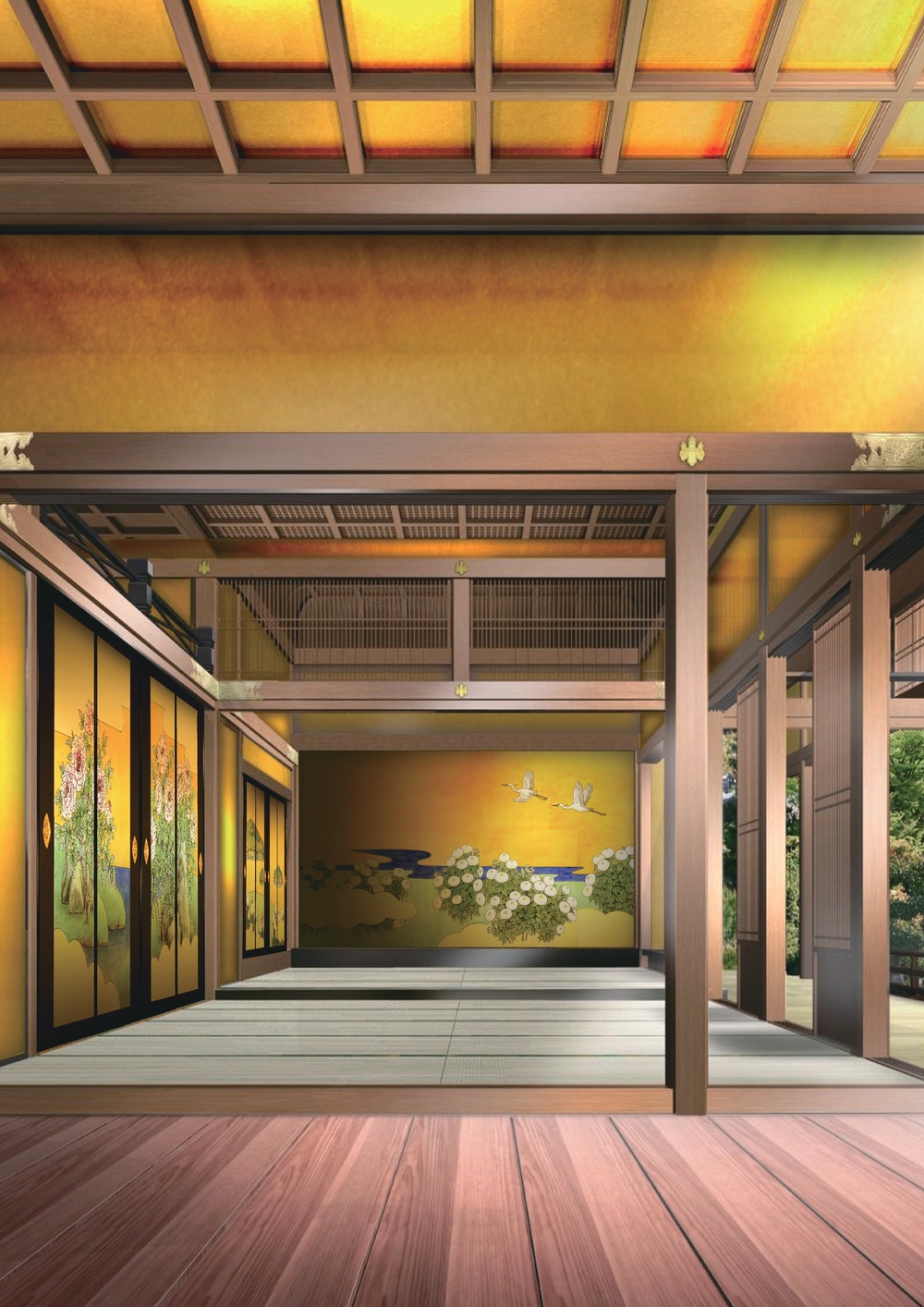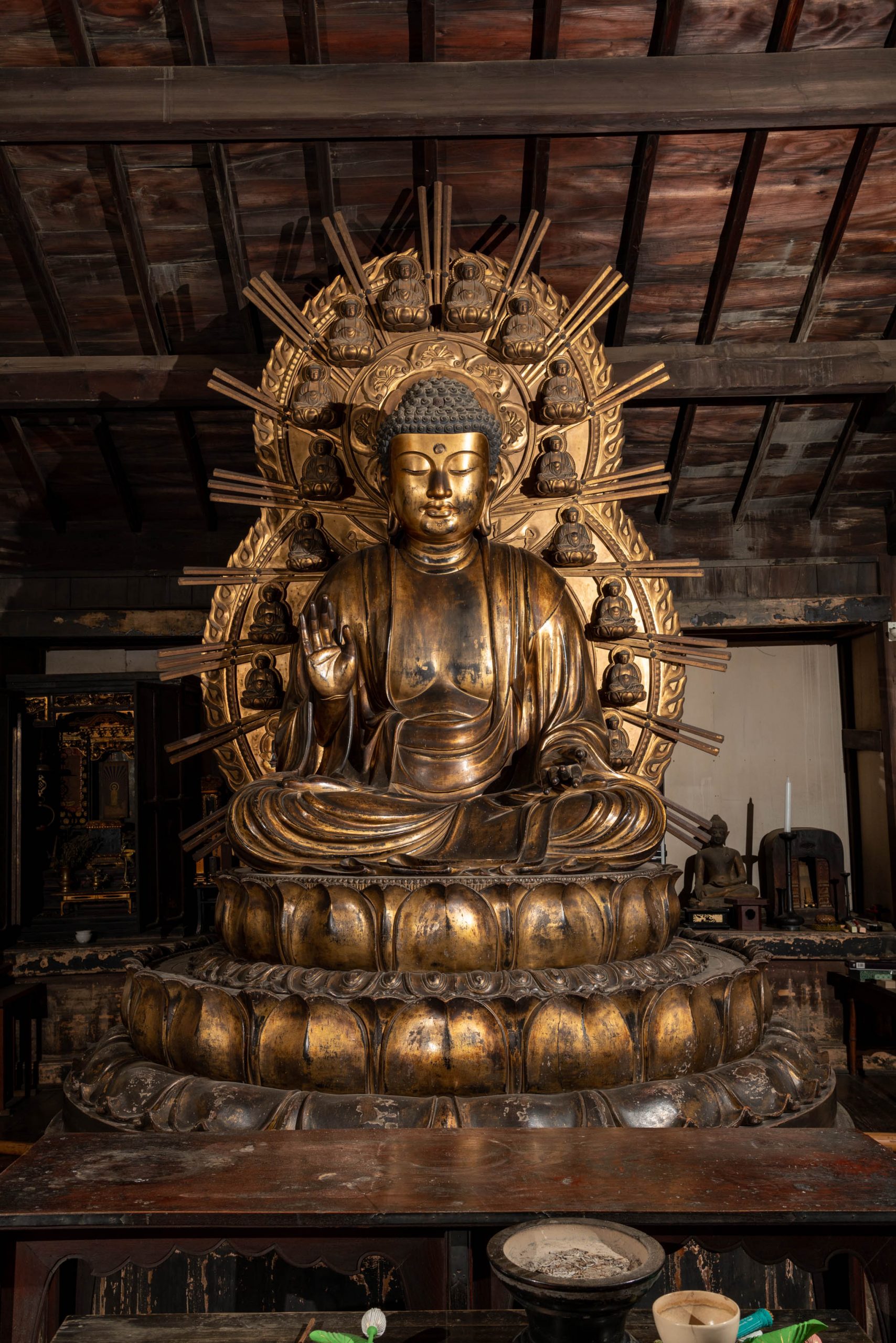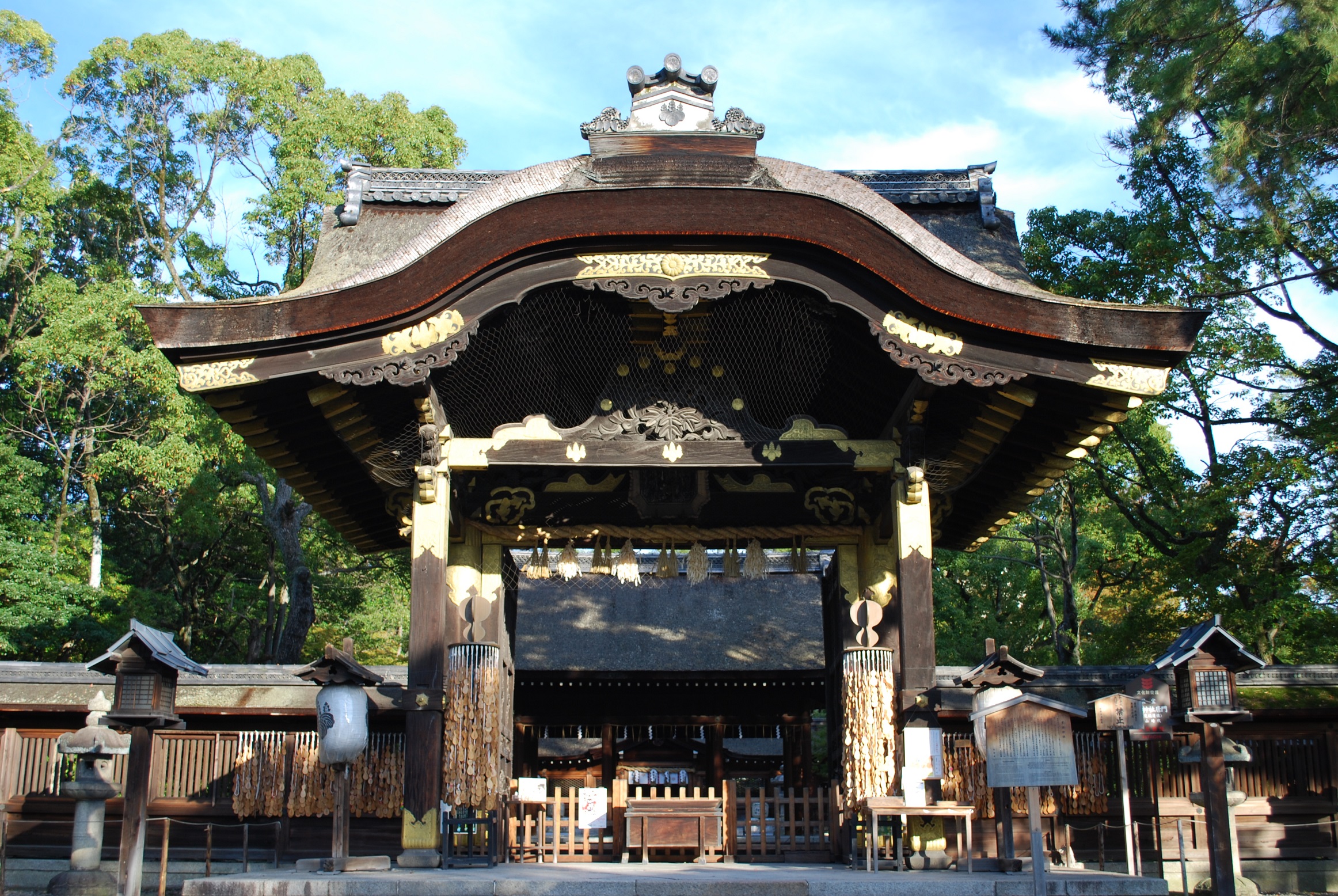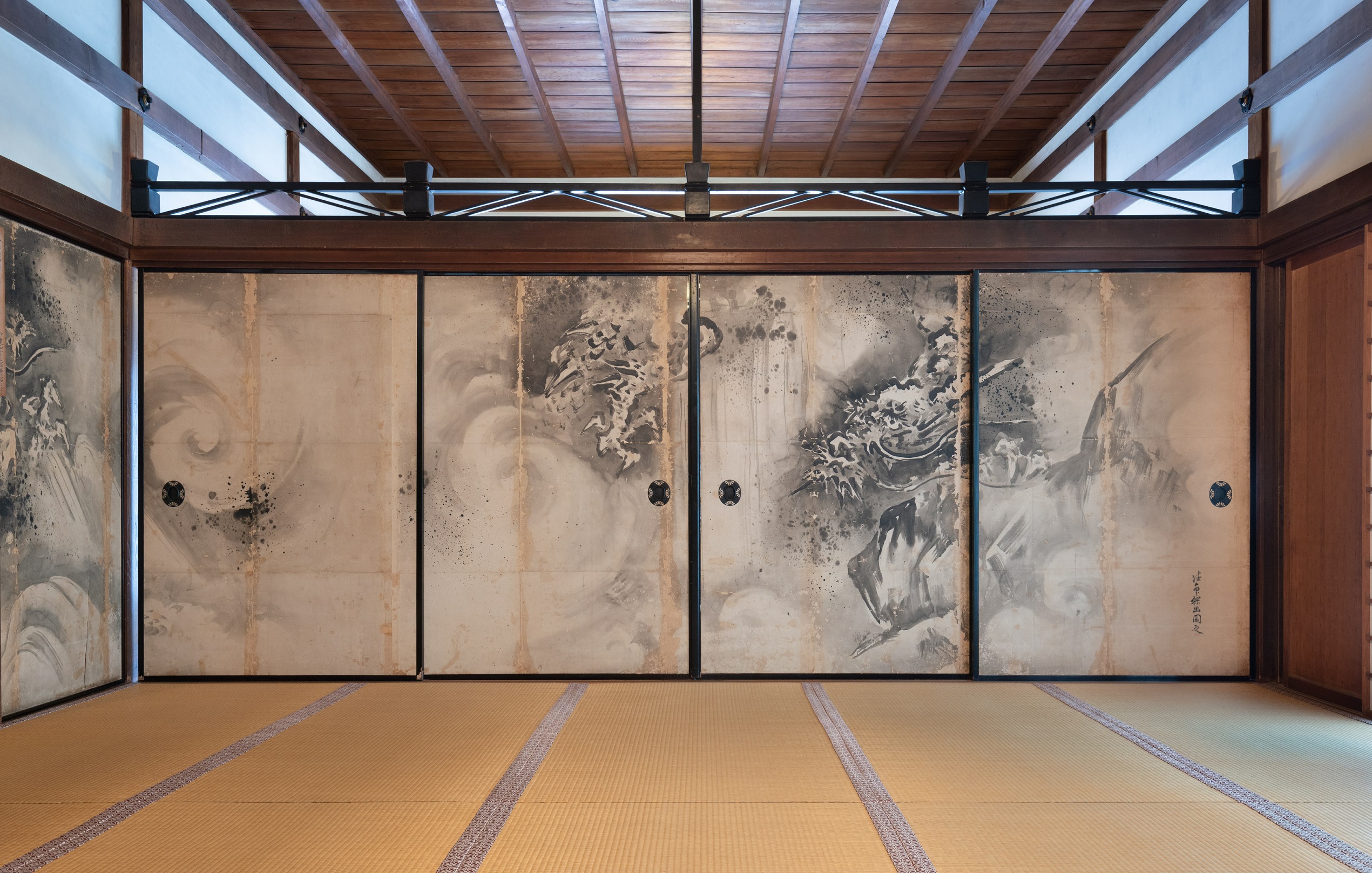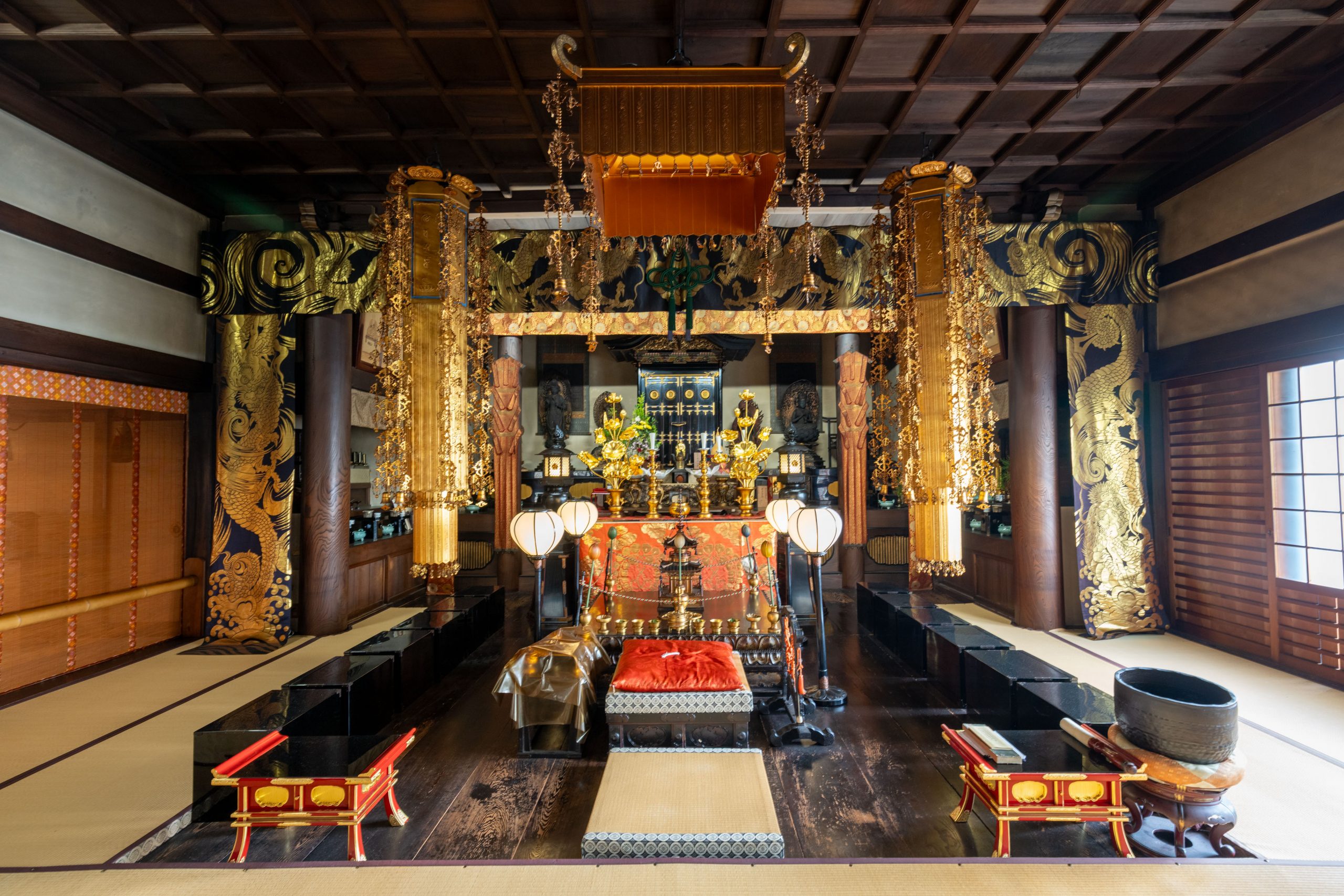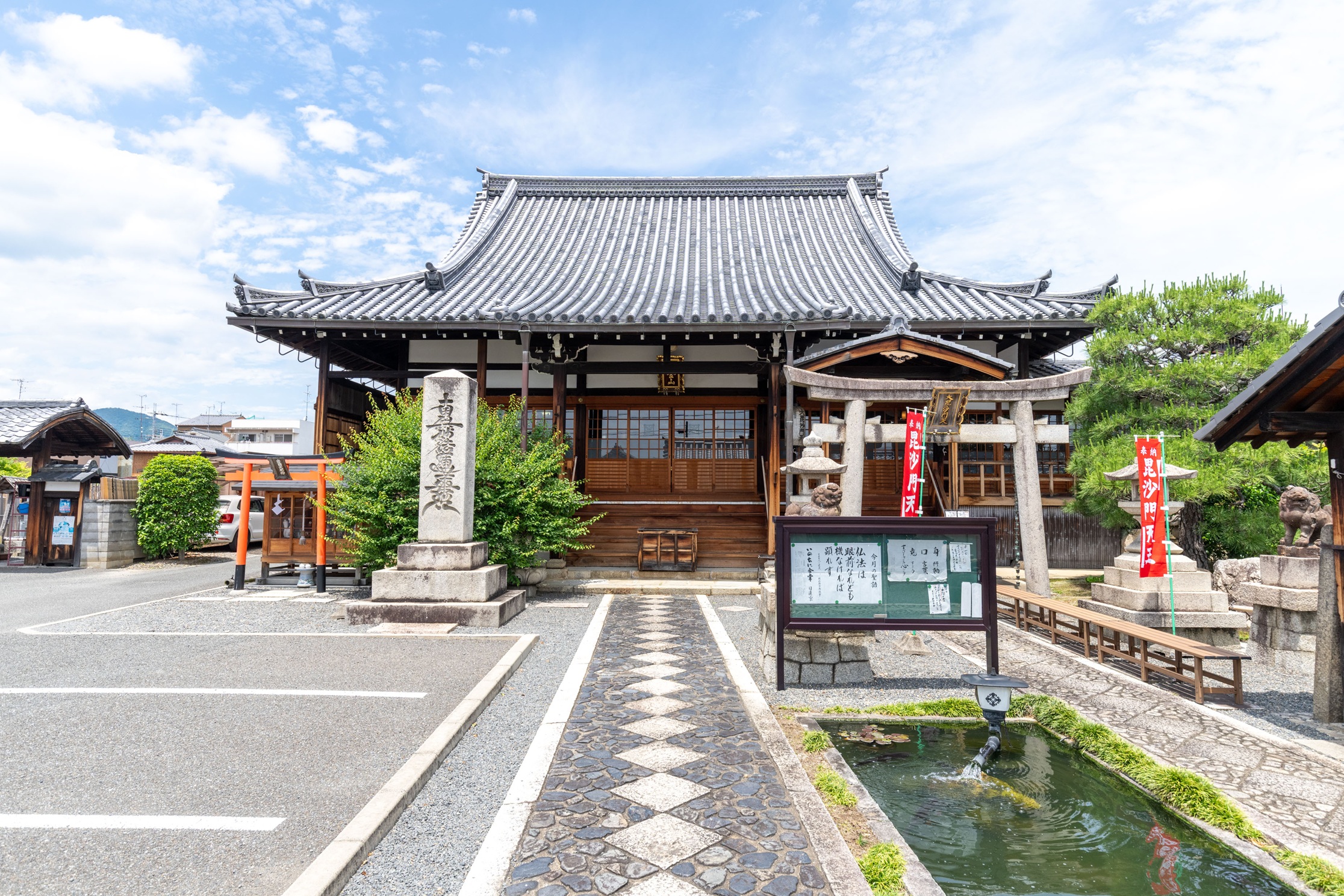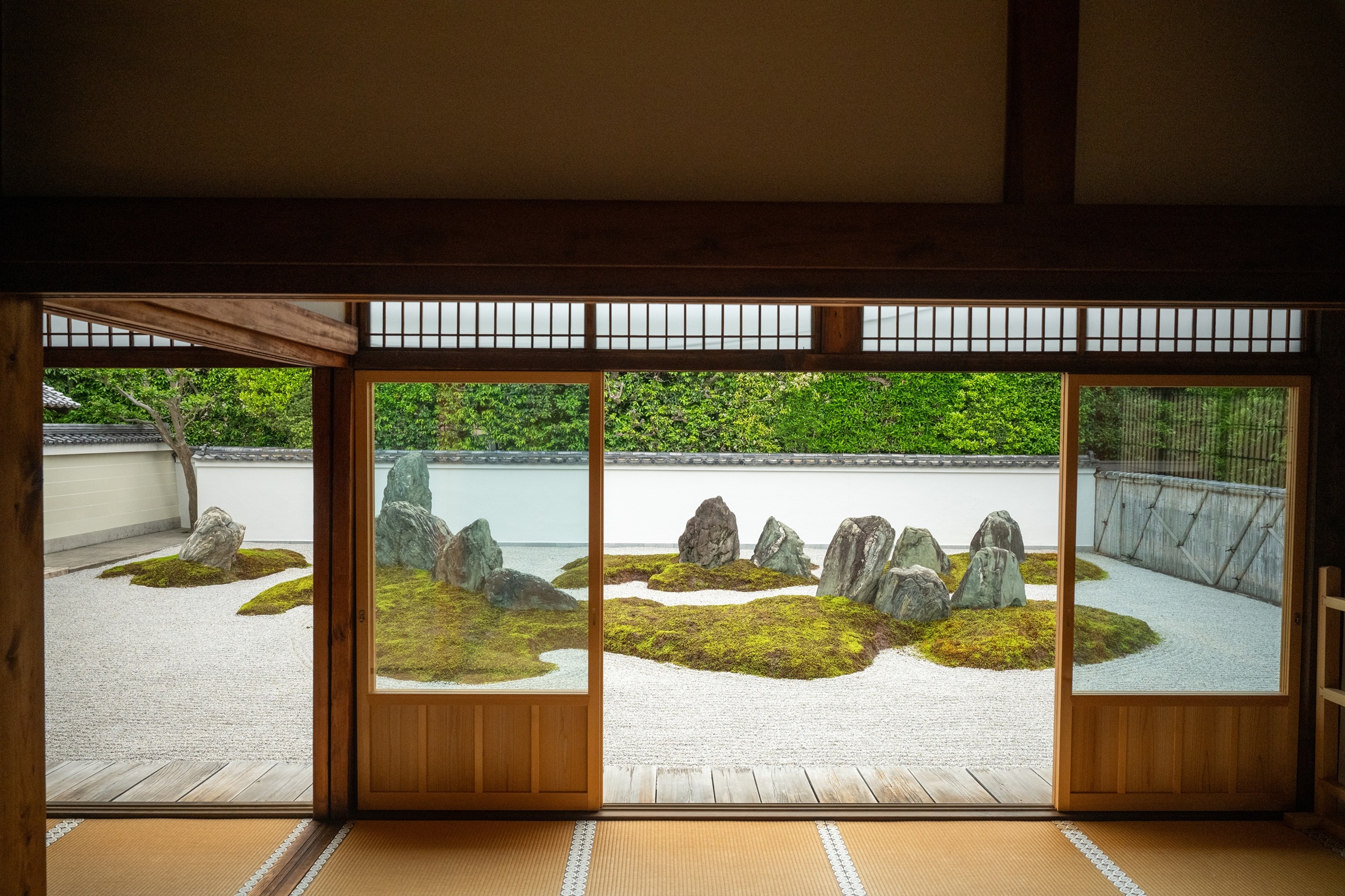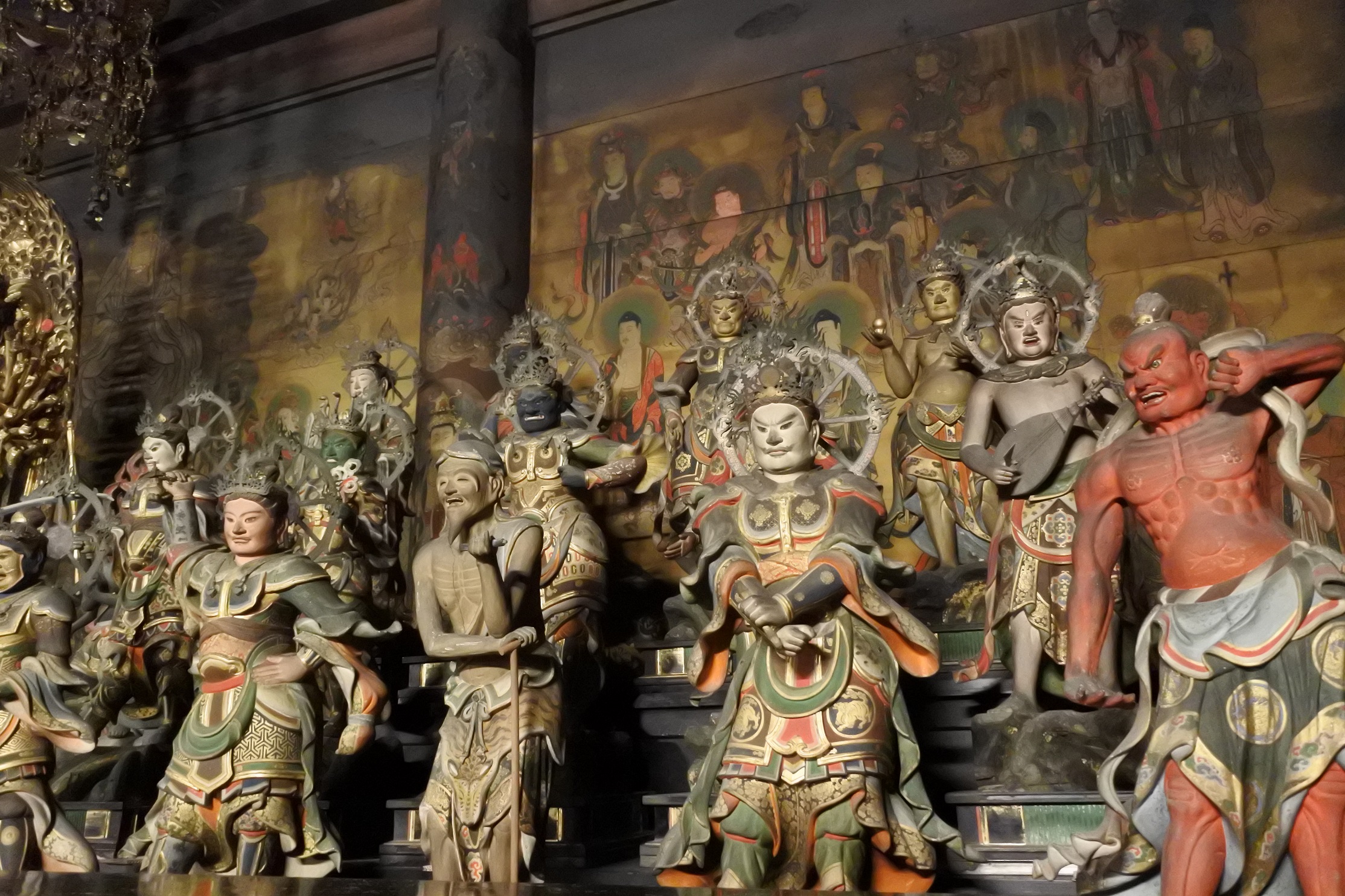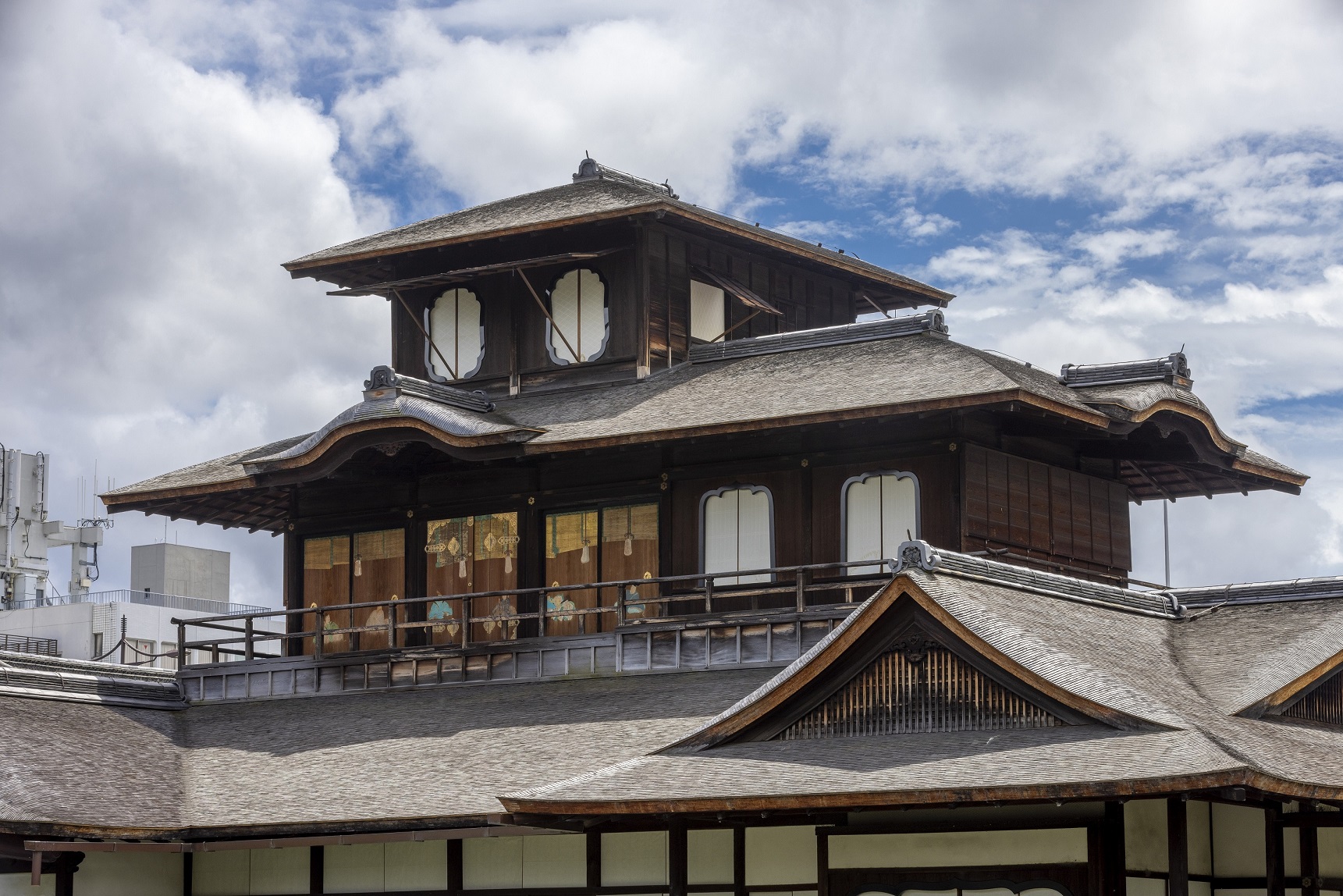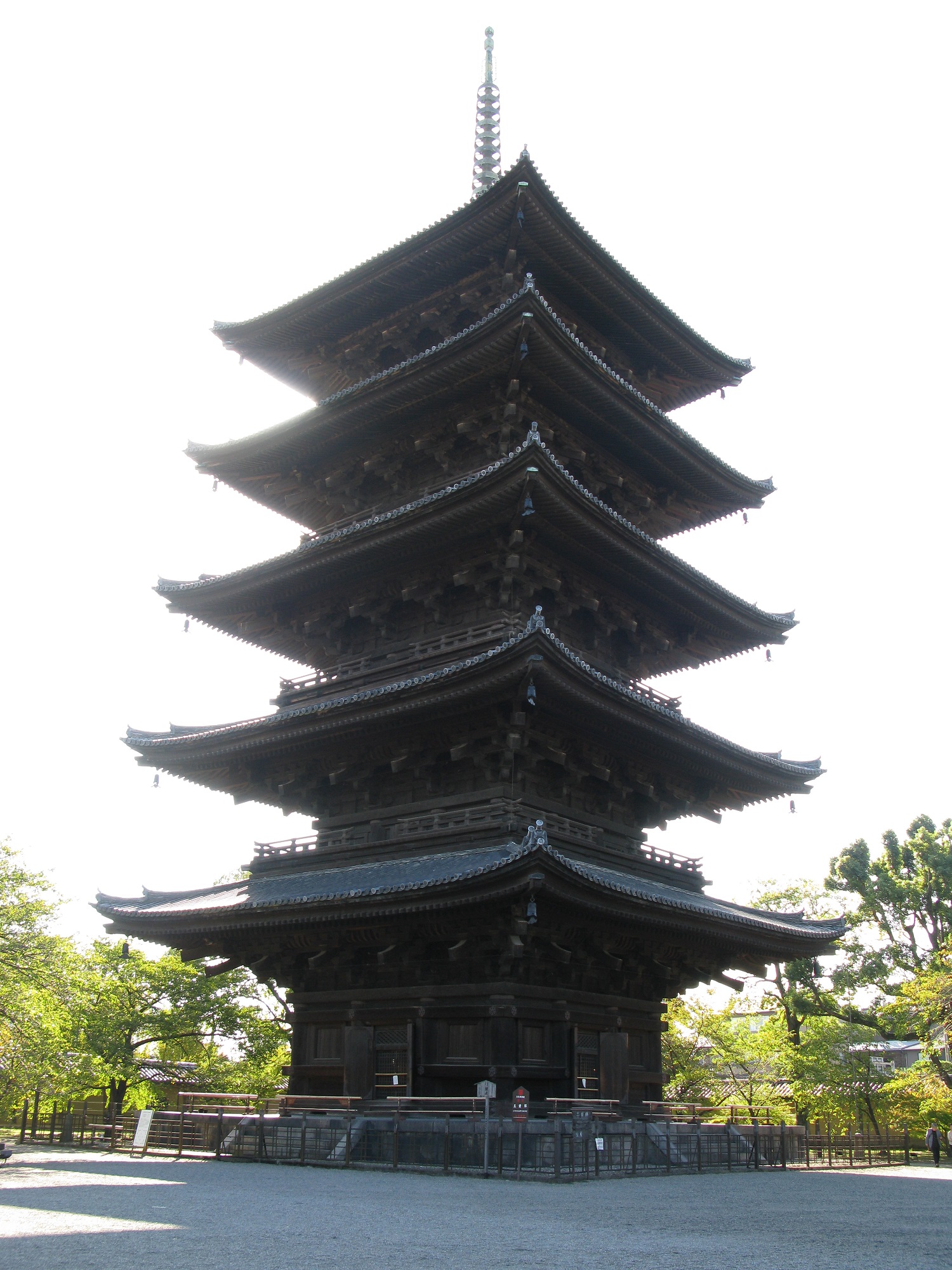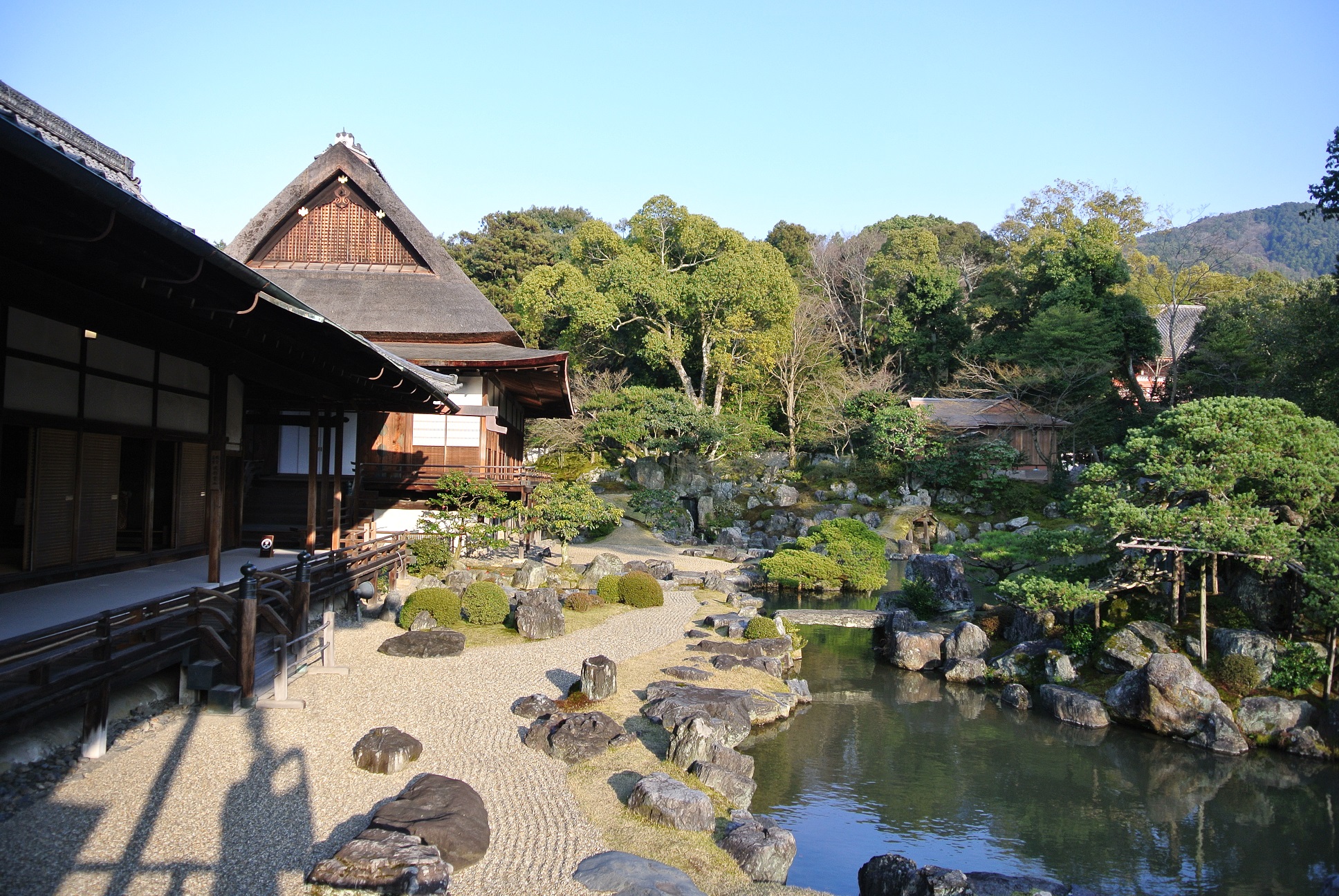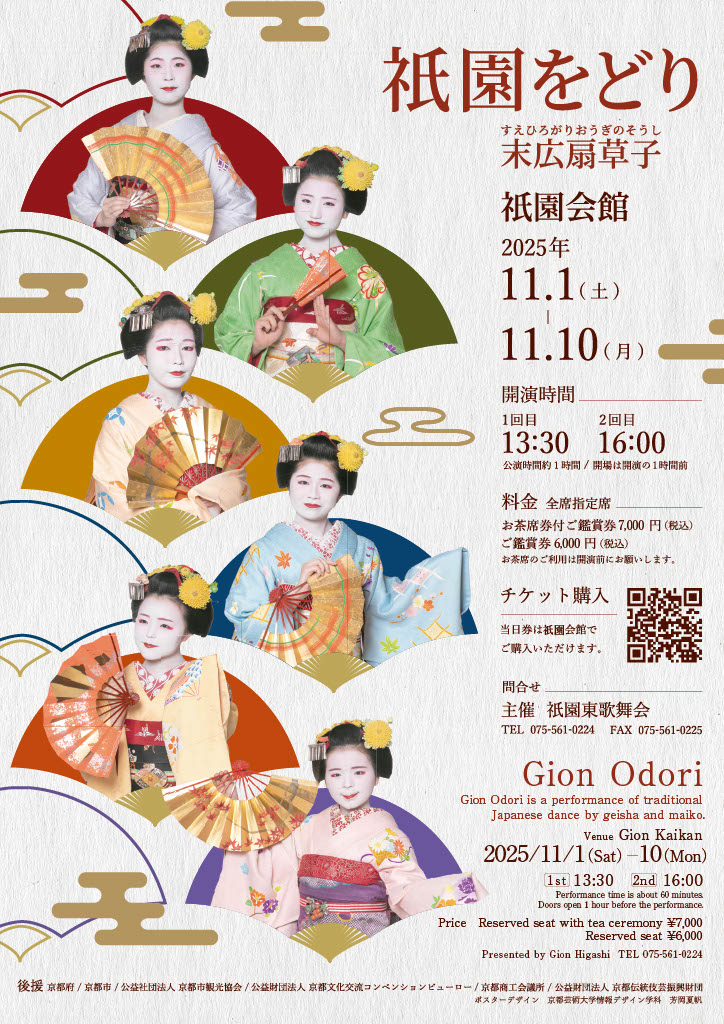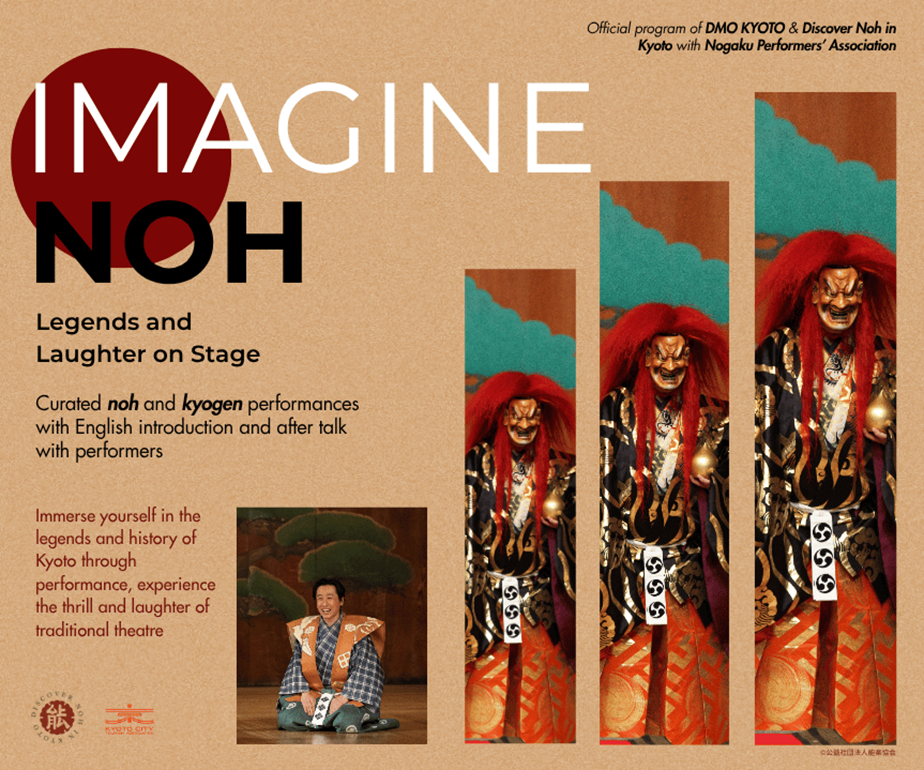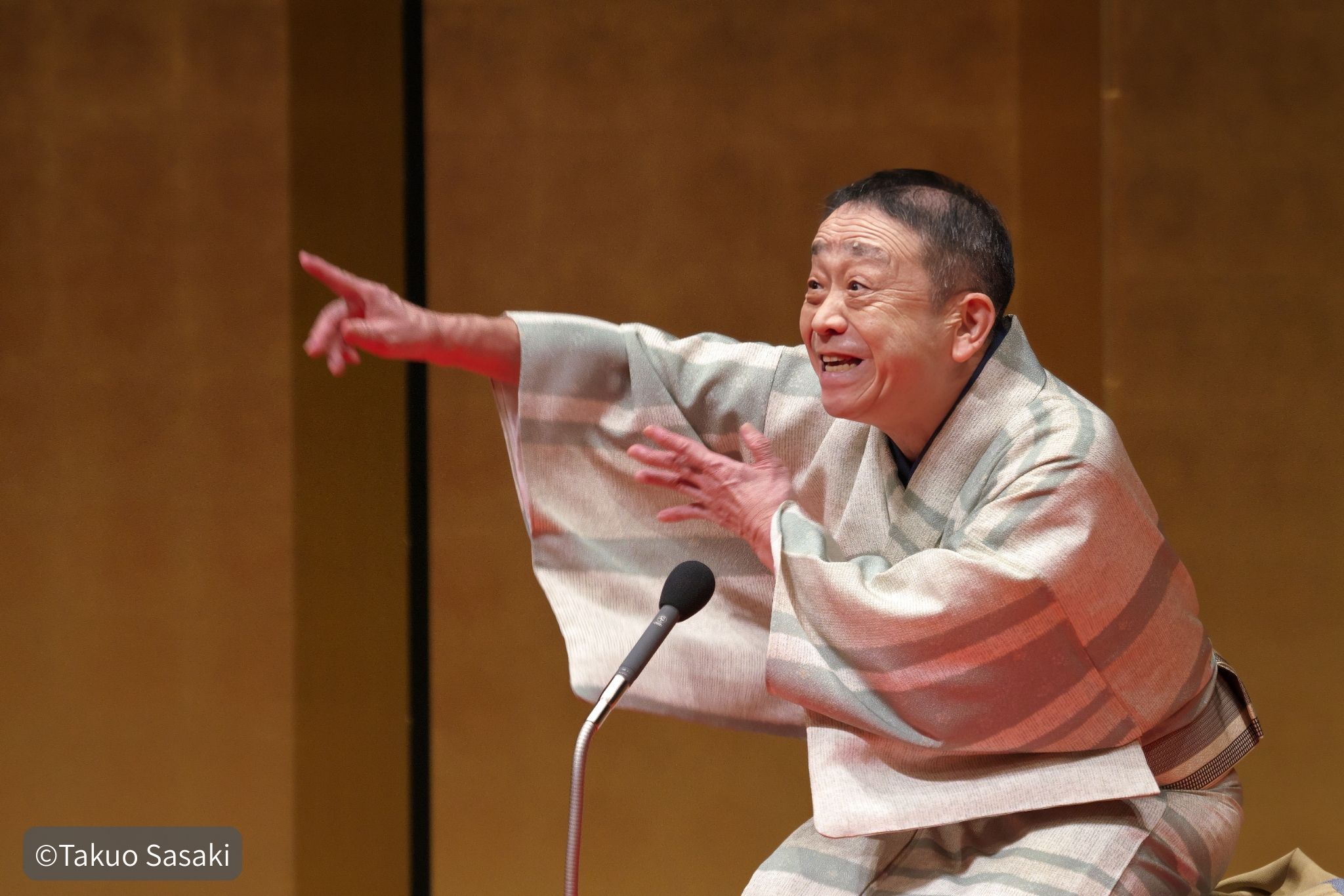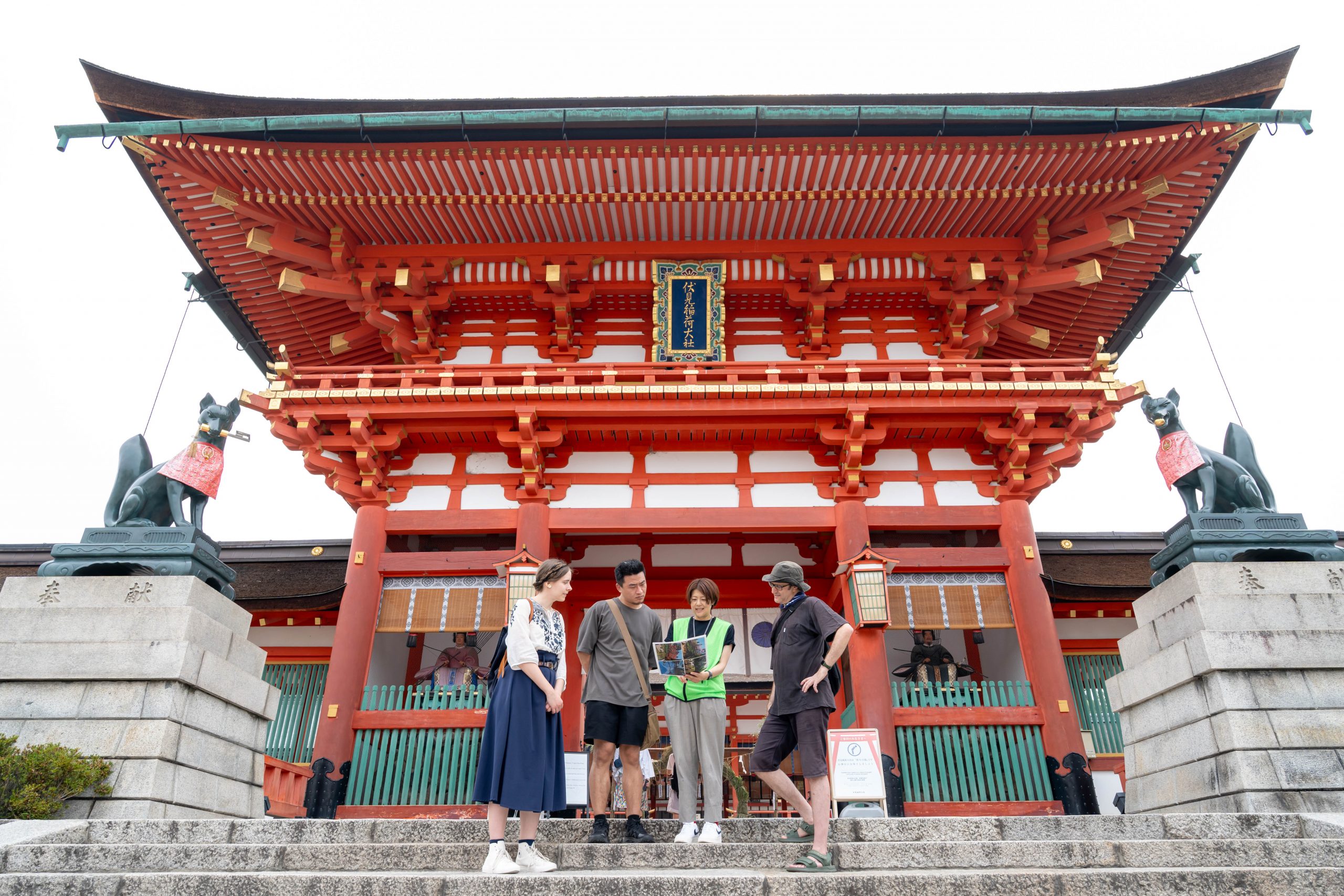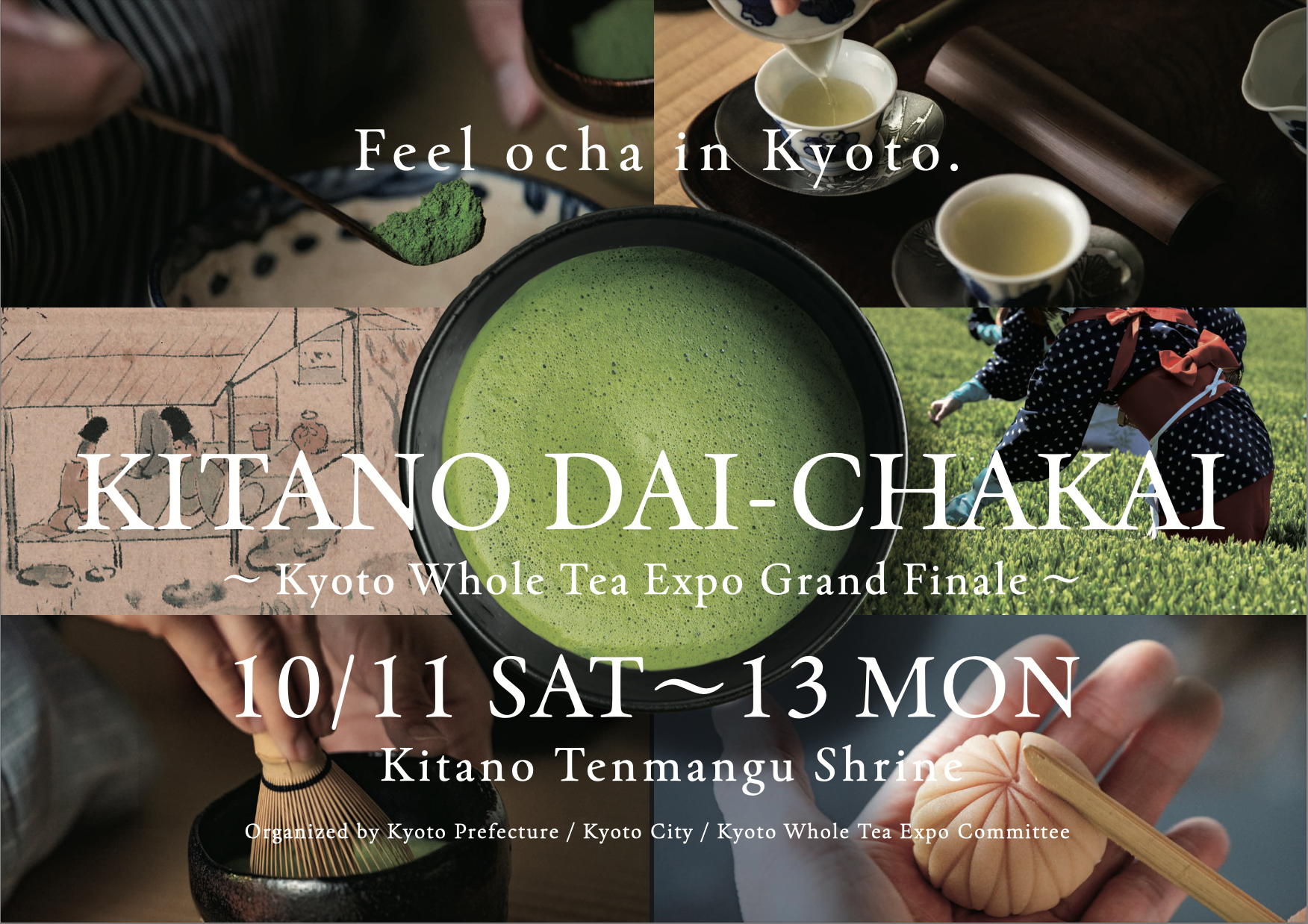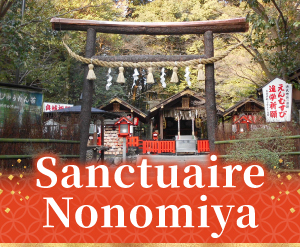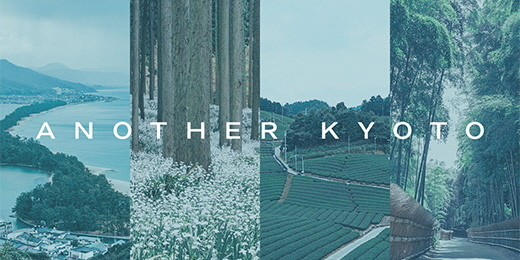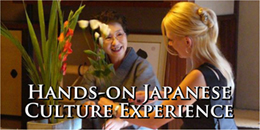Les Ouvertures Spéciales d'Hiver de Kyoto sont un programme permettant de visiter des sites exceptionnels, notamment des temples, des sanctuaires et d'autres bâtiments historiques d'importance culturelle de Kyoto, pendant une période limitée en hiver. Ce programme est organisé autour de thèmes différents chaque année, favorisant ainsi l'appréciation thématique des richesses historiques et culturelles. Bien que Kyoto compte de nombreux sites patrimoniaux, dont de nombreux Trésors Nationaux et Biens Culturels Importants, seule une partie limitée d'entre eux est régulièrement présentée au public.
Une partie des droits d’entrée sera utilisée pour l’entretien et la préservation de ces sites historiques et de leurs installations, afin que les biens culturels puissent être transmis aux générations futures.
Dates
Du 9 janvier (ven.) au 18 mars (mer.) 2026
Certains lieux ont des horaires d'ouverture différents. Veuillez consulter la fiche de chaque lieu pour plus de détails.
Il peut également y avoir des dates ou des heures où l'exposition publique n'est pas possible, en raison d'événements cérémoniels ou de conditions météorologiques (typhon, etc.). Des informations à jour seront publiées sur ce site web ; veuillez donc vous renseigner avant votre visite.
Horaires d'ouverture spéciaux
10h00 à 16h30 (dernière entrée 16h00)
*Les horaires varient selon les lieux. Veuillez consulter les sections de chaque lieu pour plus de détails.
Frais d'admission (par place)
• Adultes : 800 ¥
・Âge 6 – 12 ans : 400 ¥
*Gratuit pour les enfants de 5 ans et moins
*Les tarifs varient selon les lieux. Veuillez consulter la section dédiée à chaque lieu pour plus de détails.
NOTE
Lors de votre visite dans les temples, sanctuaires, etc., nous vous demandons de bien vouloir respecter les points suivants :
- Interdiction de fumer
- Ne pas boire
- Ne pas manger
- Il est interdit de prendre des photos dans certaines zones. Veuillez suivre les instructions de chaque lieu pour prendre des photos. Certains lieux peuvent interdire la photographie de zones ou d'objets liés au culte. Nous vous demandons votre compréhension.
- Veuillez retirer votre sac à dos ou votre sac en bandoulière ou le porter devant vous afin de protéger les biens culturels. Si possible, veuillez enregistrer vos bagages volumineux. Veuillez éviter de visiter le site pieds nus.
- Veuillez ne toucher aucun bien culturel (tableaux sur les cloisons, statues bouddhistes, etc.).
*Certains temples peuvent être fermés pour les services bouddhistes sans préavis.
*Les conseils sur place sont disponibles en japonais uniquement. Les informations en anglais seront fournies sous forme imprimée ou numérique.
Détails
1. Temple de Kodai-ji
2. Temple Hōkō-ji
3. Sanctuaire Toyokuni-jinja, salle Shoin et salle du trésor
4. Temple Daitoku-ji, salle Hatto et salle Kyo-zo
5. Temple Daitoku-ji, temple Daikō-in
6. Temple Nishijin Koshō-ji
7. Temple Fukushō-ji
8. Temple Kekō-ji
9. Temple Kōsei-ji
10. Salle Kannondo du temple Ninna-ji
11.Nishi Hongwan-ji Hiunkaku (Pavillon des nuages volants)
12. Temple Tō-ji, pagode à cinq étages
13. Temple Daigo-ji, temple Sanbō-in
1. Temple de Kodai-ji
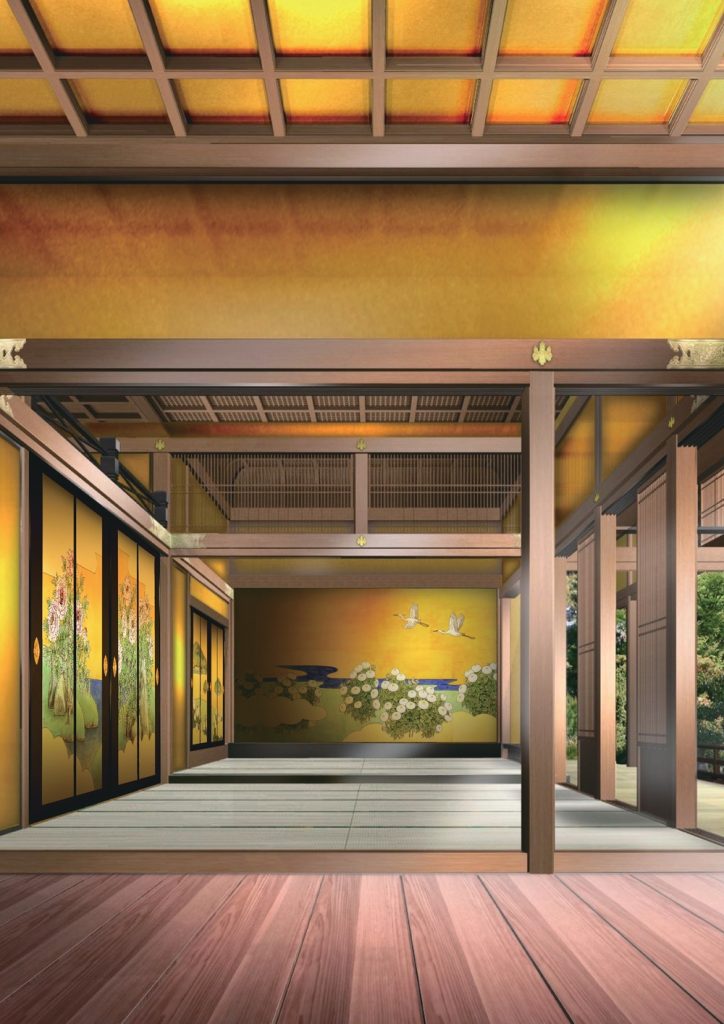
Hall de réception — actuellement en reconstruction (image conceptuelle)
Le temple Kōdai-ji fut construit en 1606 par Dame Nene pour le repos de l'âme de son époux, le seigneur de guerre Toyotomi Hideyoshi, décédé après l'unification du Japon. Le temple possède un jardin avec un étang et une bambouseraie, et abrite de nombreux édifices et trésors, chefs-d'œuvre du style flamboyant de l'époque Momoyama (1568-1600), parmi lesquels les salons de thé Kasa-tei et Shigure-tei, qui furent transférés du château de Fushimi, résidence d'Hideyoshi.
Autrefois, le temple abritait une magnifique salle de réception, initialement construite par Hideyoshi pour accueillir des banquets au château de Fushimi, puis déplacée ici. Détruite par un incendie en 1789, elle est aujourd'hui en cours de reconstruction, la première depuis 237 ans. Bien que les travaux ne soient pas terminés avant l'été 2026 environ, les visiteurs du hall principal, lors des ouvertures spéciales d'hiver, pourront admirer des peintures dorées fusuma-e réalisées spécialement pour orner la salle restaurée. Des objets d'artisanat chers à Hideyoshi, ainsi que de précieux trésors du temple liés aux seigneurs de guerre de la période Sengoku, seront également exposés.
| Dates | Du 9 janvier (ven.) au 4 mars (mer.) 2026 |
| Heures | 9h00 – 17h30 (Entrée jusqu'à 17h00) |
| Frais d'admission | Adultes : 600 ¥ / 12-18 ans : 250 ¥ (Le prix comprend l'entrée générale) |
| Accéder | • Depuis la gare de Tofuku-ji (ligne JR Nara), prenez la ligne Keihan jusqu'à la gare de Gion-Shijo. Comptez 15 minutes de marche depuis la gare. • Depuis la gare de Kyoto, prenez le bus n° 206 et descendez à l'arrêt Higashiyama Yasui. À 5 minutes à pied de l'arrêt de bus. |
2. Temple Hōkō-ji
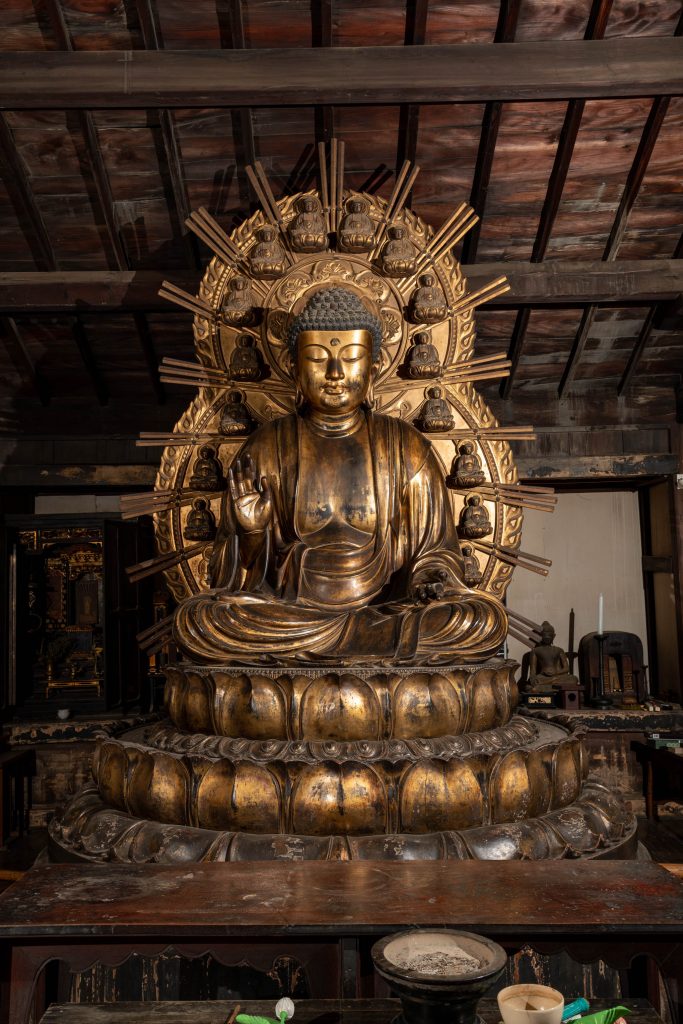
Le temple Hōkō-ji fut construit par Toyotomi Hideyoshi pour vénérer une statue géante de Bouddha, à l'instar du temple Tōdai-ji de Nara. Un vaste hall de culte abritant une statue de dix-neuf mètres de haut y fut érigé, mais il fut détruit par un incendie et reconstruit à plusieurs reprises. Le hall principal abrite aujourd'hui l'image principale du temple, une statue de Rushana-butsu (Vairocana) assise, dix fois plus petite que la statue géante d'origine. À l'occasion des ouvertures spéciales d'hiver de Kyoto, une petite image de la divinité Daikokuten, de la taille d'une paume, précieusement conservée par Hideyoshi lui-même, sera présentée au public. De plus, les visiteurs pourront admirer de près une cloche géante. Cette cloche est considérée comme l'une des « trois grandes cloches du Japon » de par sa taille, et est également connue pour un épisode où une inscription gravée sur elle provoqua un conflit déclenchant une guerre qui mena finalement à la chute de la famille Toyotomi.
| Dates | Du 9 janvier (ven.) au 18 mars (mer.) 2026 |
| Heures | 10h00 – 16h30 (Entrée jusqu'à 16h00) |
| Frais | Adultes : 800 ¥ / Enfants de 6 à 12 ans : 400 ¥ |
| Accéder | • Depuis la gare de Tofuku-ji (ligne JR Nara), prenez la ligne Keihan jusqu'à la gare de Shichijo. Comptez 10 minutes de marche depuis la gare. • Depuis la gare de Kyoto, prenez le bus n° 206 ou n° 208 et descendez à l'arrêt Hakubutsukan Sanjusangendomae. À 5 minutes à pied de l'arrêt de bus. |
3. Sanctuaire Toyokuni-jinja, salle Shoin et salle du trésor
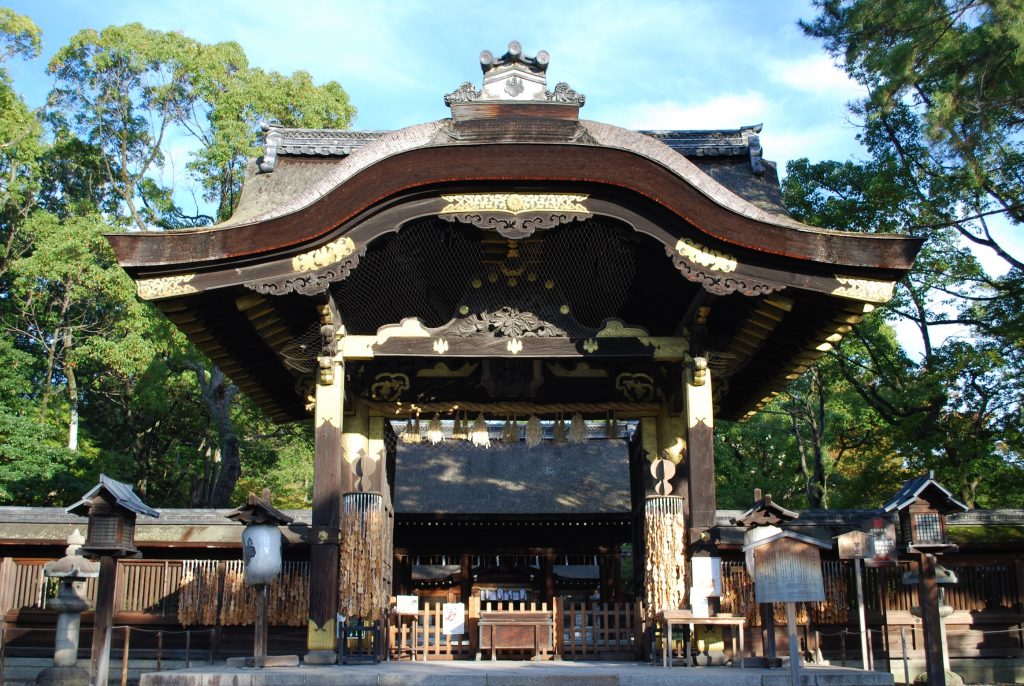
Le sanctuaire Toyokuni-jinja, dédié à Toyotomi Hideyoshi, est un lieu de prière réputé pour la réussite professionnelle, la chance et les relations harmonieuses. Son portail à pignon (karamon), construit autour du XVIe siècle, est orné de sculptures raffinées de carpes et de grues et est classé Trésor national.
À l'occasion des ouvertures hivernales spéciales du sanctuaire de Kyoto, une salle d'accueil (shoin) sera spécialement aménagée pour le public. On pourra y admirer des objets exceptionnels, tels qu'un haori porté par Hideyoshi et un paravent Rakuchū-Rakugai-zu représentant une carte de Kyoto. De plus, la salle des trésors du sanctuaire sera accessible au public. On pourra y découvrir des objets comme un oreiller en bois en forme de baku (une créature mythologique dévorant les rêves) utilisé par Hideyoshi, ainsi qu'une de ses molaires. Une exposition spéciale sera également proposée pour admirer le paravent Toyokuni Sairei-zu (bien culturel important), qui représente l'ancien hall des statues, et le Honebami-Tōshirō, un magnifique wakizashi dont la lame est gravée d'un dragon et de Fudō Myōō (la divinité Acala).
*Honebami-Tōshirō sera exposée jusqu'au 3 février (mardi), après cette date, une réplique sera exposée à la place de l'original.
| Dates | Du 9 janvier (ven.) au 18 mars (mer.) 2026 |
| Heures | 9h00 – 16h30 (Entrée jusqu'à 16h00) |
| Frais d'admission | Adultes : 1 000 ¥ / Enfants de 6 à 12 ans : 500 ¥ |
| Accéder | • Depuis la gare de Tofuku-ji (ligne JR Nara), prenez la ligne Keihan jusqu'à la gare de Shichijo. Comptez 10 minutes de marche depuis la gare. • Depuis la gare de Kyoto, prenez le bus n° 206 ou n° 208 et descendez à l'arrêt Hakubutsukan Sanjusangendo-mae. À 5 minutes à pied de l'arrêt de bus. |
4. Temple Daitoku-ji, salle Hatto et salle Kyo-zo
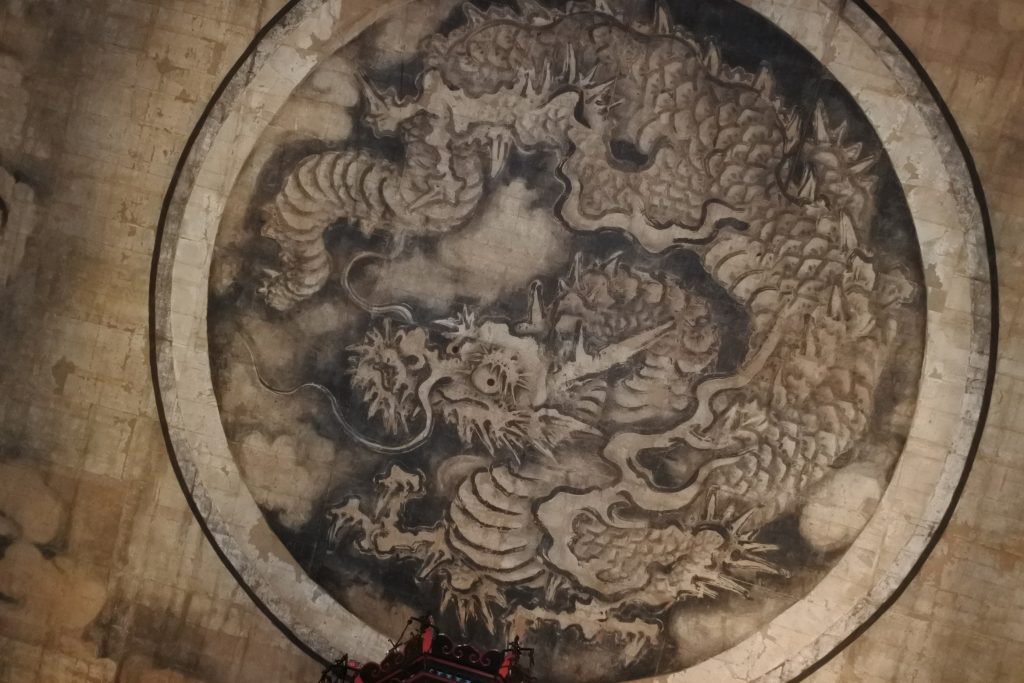
Le Daitoku-ji est un temple zen qui fêtera son sept centième anniversaire en 2026.
La plupart des bâtiments du temple principal sont habituellement fermés au public, mais les visites du Hattō (Palais du Dharma) seront exceptionnellement autorisées lors des ouvertures hivernales de Kyoto. Un dragon est représenté au plafond du Hattō. Peint au XVIIe siècle par Kanō Tan'yū, ce dragon est célèbre sous le nom de « dragon rugissant », car le son qui résonne lorsqu'on applaudit dans le hall est censé évoquer le rugissement d'un dragon. Le Kyo-zo, également ouvert au public, est un dépôt de sutras contenant une armoire octogonale de quatre mètres de haut renfermant 3 500 sutras. On dit qu'un seul tour de cette armoire permet d'accumuler des mérites bouddhistes équivalents à la lecture de tous les sutras qu'elle renferme.
| Dates | Du 9 janvier (ven.) au 18 mars (mer.) 2026 |
| Heures | 10h00 – 16h30 (Entrée jusqu'à 16h00) |
| Frais d'admission | Adultes : 800 ¥ / Enfants de 6 à 12 ans : 400 ¥ |
| Accéder | • Depuis la gare de Nijo (ligne JR Sagano), prenez le bus n° 206 et descendez à l'arrêt Daitokuji-mae. À 7 minutes à pied de l'arrêt de bus. • Depuis la gare de Kyoto, prenez la ligne Karasuma du métro jusqu'à la station Kitaoji, puis le bus n° 204, 205 ou 206 et descendez à l'arrêt Ditokuji-mae. Comptez 7 minutes de marche depuis l'arrêt de bus. |
5. Temple Daitoku-ji, temple Daikō-in
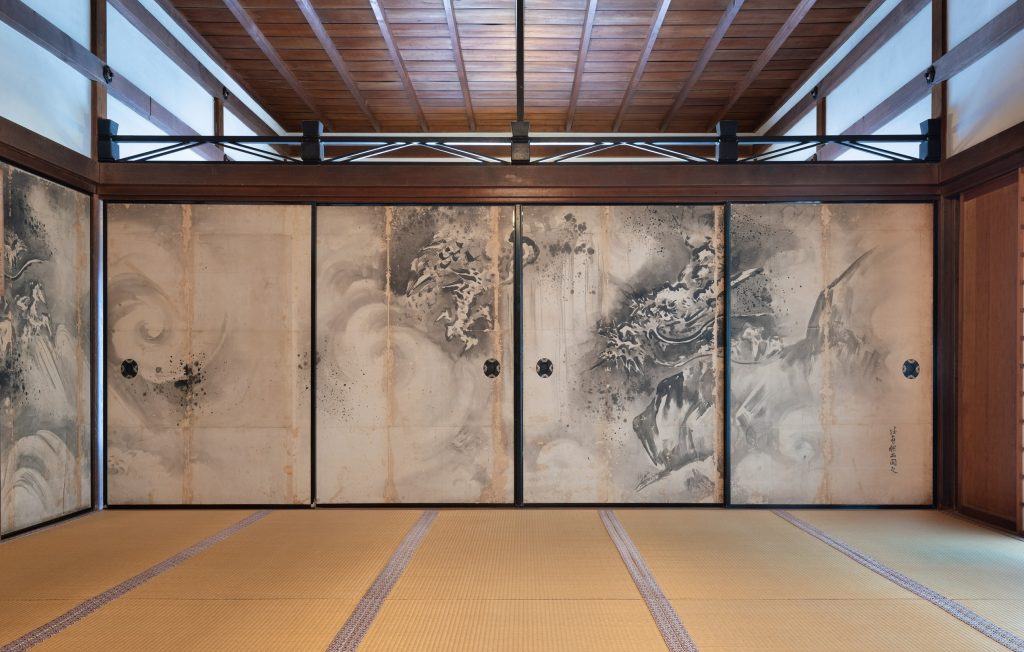
Le temple Daikō-in fut initialement construit à Nara pour prier pour l'âme d'Hidenaga, le frère cadet de Toyotomi Hideyoshi, puis déplacé au temple Daitoku-ji. Le bâtiment actuel date de l'époque d'Edo et a été reconstruit à l'identique à son emplacement actuel.
Le hall principal du temple abrite une statue en bois d'Hidenaga, et un Koku-Unryū-zu (une peinture représentant un dragon dans des nuages sombres) orne les portes coulissantes fusuma. Cette peinture est attribuée à Kanō Tan'yū, peintre renommé du XVIIe siècle, et était à l'origine un byōbu-e (peinture sur paravent) avant d'être fixée à nouveau sur ces portes. Par ailleurs, le Hoan, une petite salle de thé dont la surface au sol équivaut à trois tatamis, sera exceptionnellement ouverte au public.
| Dates | Du 9 janvier (vendredi) au 18 mars (mercredi) 2026 *Fermé au public du 15 février (dimanche) au 17 février (mardi). |
| Heures | 10h00 – 16h30 (Entrée jusqu'à 16h00) |
| Frais d'admission | Adultes : 800 ¥ / Enfants de 6 à 12 ans : 400 ¥ |
| Accéder | • Depuis la gare de Nijo sur la ligne JR Sagano, prenez le bus urbain n° 206 et descendez à l'arrêt Kenkunjinja-mae. À 2 minutes à pied de l'arrêt de bus. • Depuis la gare de Kyoto, prenez la ligne Karasuma du métro jusqu'à la station Kitaoji, puis le bus n° 204, 205 ou 206 et descendez à l'arrêt Kenkunjinja-mae. L'arrêt de bus se trouve à 2 minutes à pied. |
6. Temple Nishijin Koshō-ji
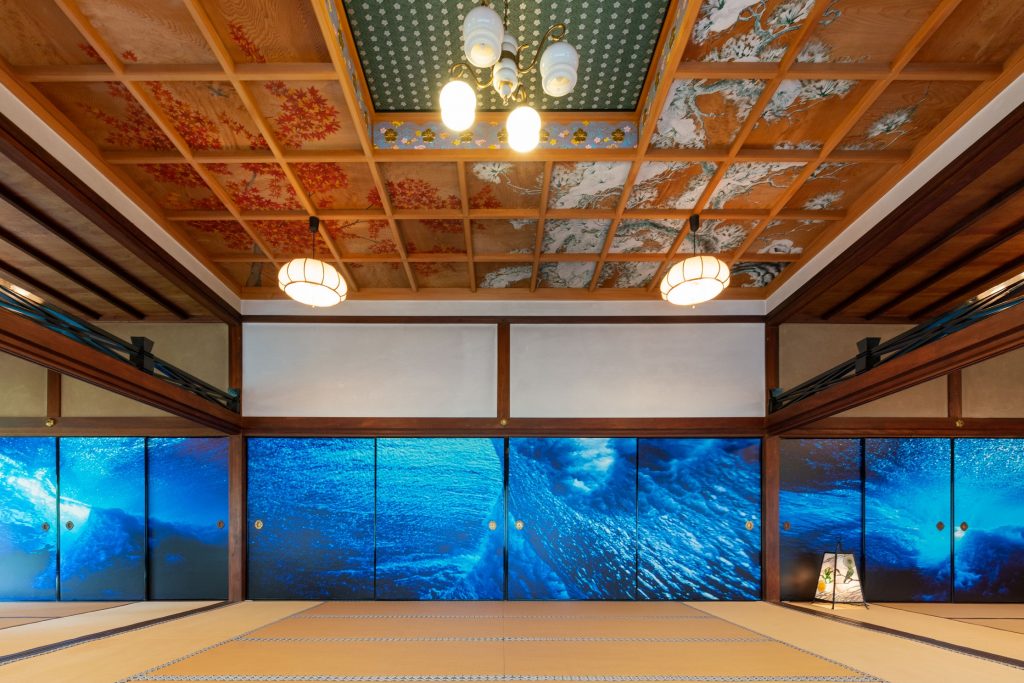
Le Nishijin Kōshō-ji est un temple associé à Furuta Oribe, un guerrier au service d'Oda Nobunaga et de Toyotomi Hideyoshi. Maître de thé réputé pour son esthétique libre et créative, Oribe est le fondateur de l'école Oribe de la cérémonie du thé.
Le plafond du hall principal est orné d'un Unryū-zu, une peinture représentant un dragon parmi les nuages, et l'image principale vénérée est celle du Bouddha Shakyamuni. Lors de l'ouverture spéciale d'hiver de Kyoto, une grande peinture Daruma-zu – l'un des plus grands portraits de Bodhidharma au Japon, habituellement exposée une seule fois par an, lors d'une journée spéciale en octobre – est présentée au public. Bodhidharma était un moine considéré comme le fondateur du bouddhisme zen en Chine.
Parmi les autres points forts, citons les portes coulissantes décorées de photographies capturant des scènes de lumière sous la mer bleue, et un salon de thé doté d'un bassin d'eau en pierre (tsukubai) installé dans un sol profondément creusé.
| Dates | Du 9 janvier (ven.) au 18 mars (mer.) 2026 |
| Heures | 10h00 – 16h30 (Entrée jusqu'à 16h00) |
| Frais d'admission | Adultes : 800 ¥ / Enfants de 6 à 12 ans : 400 ¥ |
| Accéder | • Depuis la gare de Kyoto, prenez la ligne Karasuma du métro urbain jusqu'à la station Kuramaguchi et sortez par la sortie n° 1. 13 minutes de marche depuis la station. • Depuis la gare de Kyoto, prenez le bus n° 9 et descendez à l'arrêt Tenjinkoen-mae. L'arrêt de bus se trouve à une minute à pied. |
7. Temple Fukushō-ji
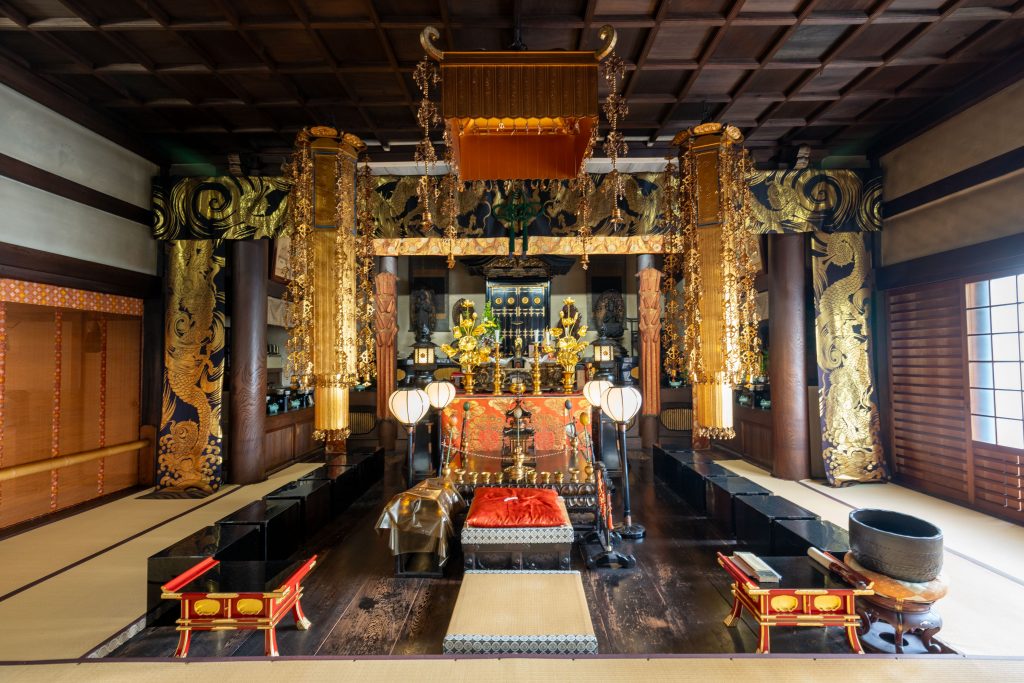
Le temple Fukushō-ji aurait été fondé par le célèbre prêtre Kūkai (774-835) et est l'un des trente-trois sites de culte de Kannon à Kyoto.
Le hall principal abrite plusieurs statues bouddhistes anciennes, dont une Shō-Kannon-Bosatsu, le « Saint Kannon Bodhisattva », vieille de plus de mille ans.
De plus, à droite du hall principal se trouve le Shōten-dō, qui abrite un petit sanctuaire cylindrique renfermant une statue de Kangiten, une image bouddhiste cachée autrefois vénérée par Toyotomi Hideyoshi. À chaque bataille, Hideyoshi y déposait une calebasse (hyōtan) en offrande pour implorer la victoire. Après chaque victoire, il emportait la calebasse chez lui. Au fur et à mesure que ces calebasses s'accumulaient, il les utilisait comme symbole (umajirushi) pour distinguer amis et ennemis sur le champ de bataille. C'est pourquoi le Fukushōji est parfois appelé « Hyōtan-dera » (« Temple de la Calebasse »). Le temple est aujourd'hui réputé comme un lieu propice aux prières pour la sécurité, la santé et la prospérité financière.
| Dates | Du 9 janvier (ven.) au 18 mars (mer.) 2026 *Fermé au public le 16 janvier (ven.), le 19 janvier (lun.), le 1er février (dim.) au 4 février (mer.), le 16 février (lun.), le 1er mars (dim.) et le 16 mars (lun.). |
| Heures | 10h00 – 16h30 (Entrée jusqu'à 16h00) |
| Frais d'admission | Adultes : 800 ¥ / Enfants de 6 à 12 ans : 400 ¥ |
| Accéder | • Depuis la gare de Kyoto ou la gare de Nijo (ligne JR Sagano), comptez 15 minutes de marche. Vous pouvez également prendre le bus n° 52 et descendre à l’arrêt Shichihonmatsu Demizu. L’arrêt de bus se trouve à 3 minutes à pied. • Depuis la gare de Kyoto, prenez le bus n° 6 ou n° 206 et descendez à l'arrêt Senbon Demizu. À 3 minutes à pied de l'arrêt de bus. |
8. Temple Kekō-ji
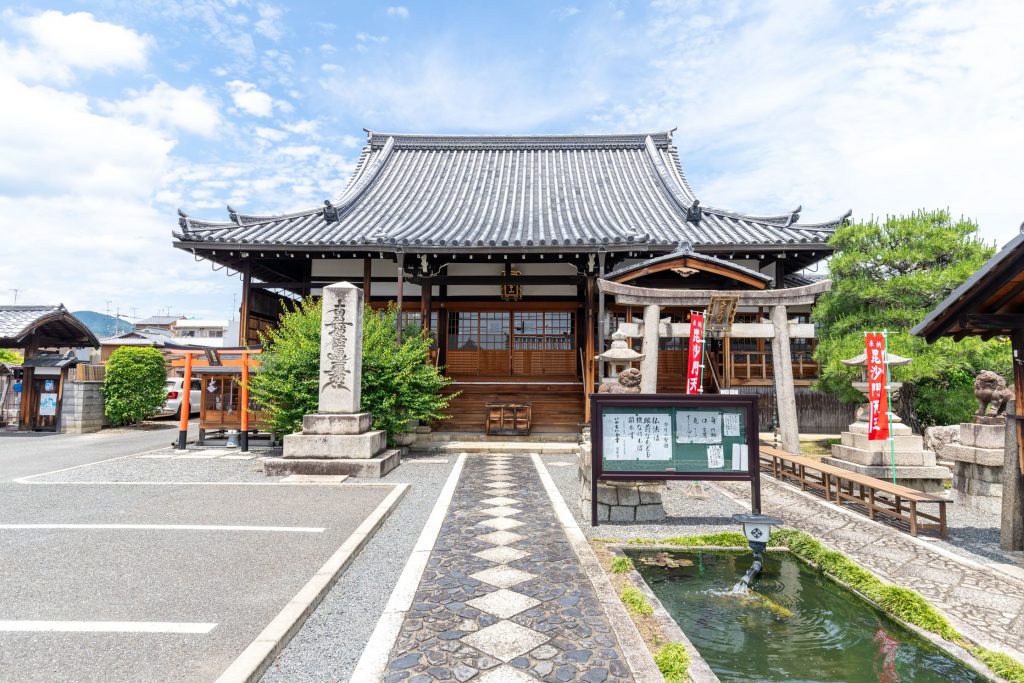
Le temple Kekō-ji a été construit en 1583 sous le patronage de Toyotomi Hideyoshi.
Les visiteurs peuvent admirer une statue de la divinité Bishamon-ten. Cette statue en bois, que l'on pense avoir été créée durant l'époque Heian (794-1185), mesure environ 160 centimètres de haut et est vêtue d'une armure. On raconte qu'elle aurait été vénérée par Hideyoshi au château de Fushimi. Elle est devenue populaire comme objet de prière pour attirer la bonne fortune.
On pense que la porte du temple a également été déplacée ici depuis le château de Fushimi au moment de la fondation du temple.
Dans le salon (shoin) se trouve la souche d'un vieux pin planté à l'origine par Hideyoshi. Cet arbre, surnommé le « Pin de la Brume » (« Shigure Matsu ») car des gouttes d'eau en tombaient mystérieusement même par temps ensoleillé, est considéré comme l'une des « sept merveilles » du quartier de Demizu-dori où se situe le Kekōji.
Des peintures et autres trésors du temple seront également accessibles au public.
| Dates | Du 9 janvier (ven.) au 18 mars (mer.) 2026 *Fermé au public le 1er février (dimanche). *Ouverture à 13h00 le 1er mars (dimanche). |
| Heures | 10h00 – 16h30 (Entrée jusqu'à 16h00) |
| Frais d'admission | Adultes : 800 ¥ / Enfants de 6 à 12 ans : 400 ¥ |
| Accéder | • Depuis la gare de Kyoto ou la gare de Nijo (ligne JR Sagano), comptez 15 minutes de marche. Vous pouvez également prendre le bus n° 52 et descendre à l’arrêt Shichihonmatsu Demizu. L’arrêt de bus se trouve à 2 minutes à pied. • Depuis la gare de Kyoto, prenez le bus n° 6 ou n° 206 et descendez à l'arrêt Senbon Demizu. À 4 minutes à pied de l'arrêt de bus. |
9. Temple Kōsei-ji
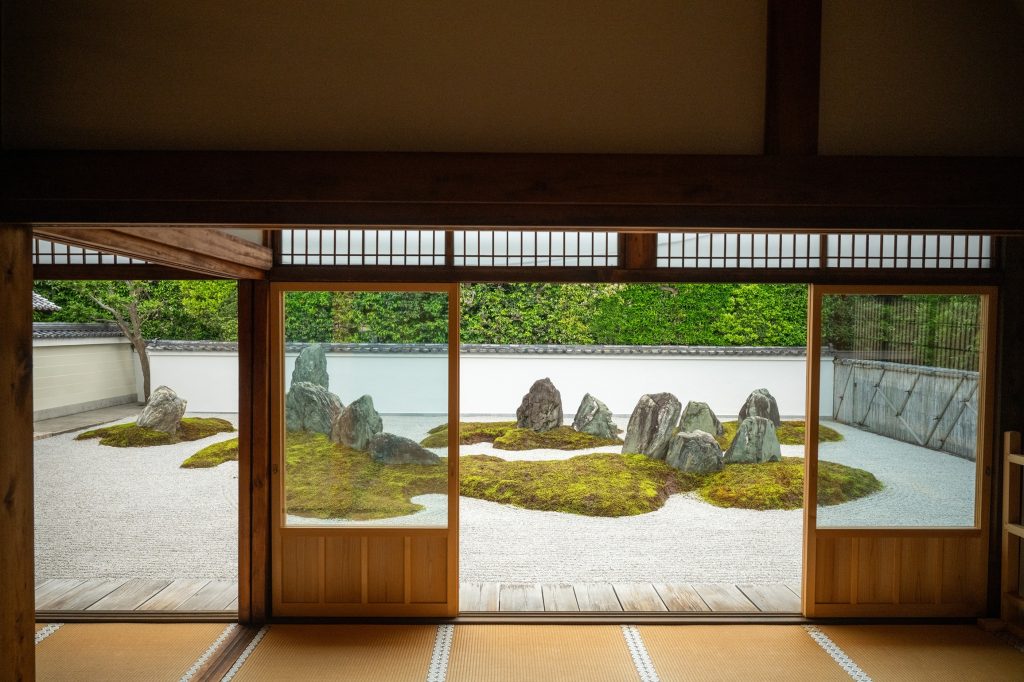
Photographie de kyotophotograph
Le temple Kōsei-ji est célèbre pour son Shinwa-no-niwa, un jardin sec qui s'étend devant le hall principal. Créé par le célèbre paysagiste Shigemori Mirei (1896-1975), ce jardin présente une conception unique où mousse et rochers forment le kanji « kokoro » (cœur/esprit).
Le hall principal abrite l'image principale du temple, un Shō-Kannon-Bosatsu que l'on pense avoir été créé pendant la période Heian (794-1185).
De plus, sur un mur du hall principal se trouve une célèbre plaque de bois datant de l'époque d'Edo (1600-1868), ornée de pivoines, de papillons et d'un chat. Selon la légende, le chat sortait de la plaque et dansait au son du shamisen. L'abbé de l'époque aurait usé de pouvoirs divins pour sceller le chat dans la plaque, mais celui-ci lui serait apparu en rêve et aurait imploré son pardon, l'abbé brisant alors le sceau. Cette plaque est considérée comme l'une des « sept merveilles » du quartier de Demizu-dori, où se situe le Kōsei-ji.
| Dates | Du 9 janvier (ven.) au 23 février (lun.) 2026 *Fermé au public le 18 janvier (dimanche) et le 8 février (dimanche). *Ouverture à 13h00 le 25 janvier (dimanche), le 1er février (dimanche) et le 15 février (dimanche). |
| Heures | 10h00 – 16h30 (Entrée jusqu'à 16h00) |
| Frais d'admission | Adultes : 800 ¥ / Enfants de 6 à 12 ans : 400 ¥ |
| Accéder | • Depuis la gare de Kyoto ou la gare de Nijo (ligne JR Sagano), comptez 15 minutes de marche ou prenez le bus n° 52 et descendez à l’arrêt Shichihon Demizu. L’arrêt de bus se trouve à 2 minutes à pied. • Depuis la gare de Kyoto, prenez le bus n° 6 ou n° 206 et descendez à l'arrêt Senbon Demizu. À 4 minutes à pied de l'arrêt de bus. |
10. Salle Kannon-do du temple Ninna-ji
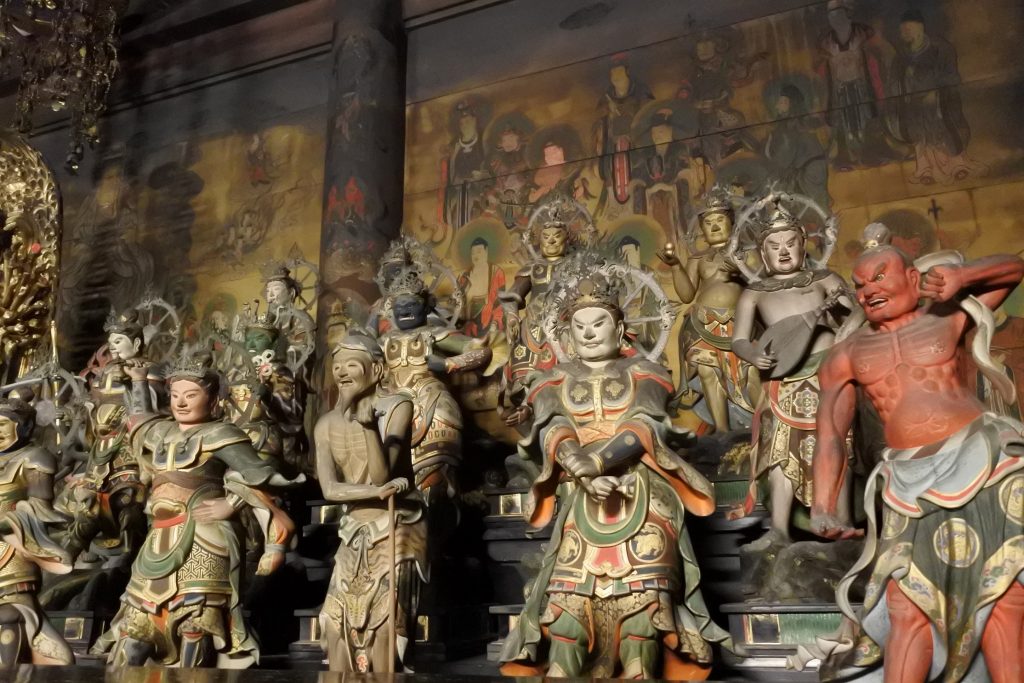
Site du patrimoine mondial
Le temple Ninna-ji, construit en 888, est inscrit au patrimoine mondial de l'UNESCO. L'empereur Uda (867-931) y est né et y a vécu plus tard en tant que premier grand moine. Ninna-ji est un temple de type monzeki. Ce terme désigne les moines bouddhistes de lignée aristocratique ou impériale, ceux qui officiaient au service de la famille impériale, ainsi que les temples où ils résidaient. Ninna-ji est le temple principal de l'école Omuro du bouddhisme Shingon.
La plupart de ses grands prêtres étaient issus de la famille impériale, et la résidence du grand prêtre s'appelait « Omuro », un terme honorifique signifiant « demeure ».
| Dates | Du 9 janvier (ven.) au 17 mars (mar.) 2026 *Fermé au public le 18 janvier (dimanche) et le 18 février (mercredi). |
| Heures | 10h00 – 16h00 (Entrée jusqu'à 15h30) de janvier à février, 10h00 – 16h30 (Entrée jusqu’à 16h00) en mars. |
| Frais d'admission | Adultes : 700 ¥ / Gratuit pour les moins de 18 ans |
| Accéder | • Depuis la gare de Kyoto ou depuis la gare d'Enmachi de la ligne JR Sagano, prenez le bus urbain n° 26 ou le bus JR et descendez à Omuro-Ninnaji. • Depuis la gare de Kyoto, prenez la ligne JR Sagano jusqu'à la gare d'Uzumasa, puis prenez la ligne Keifuku (Randen) de la gare de Satsueijo-mae jusqu'à la gare d'Omuro-Ninnaji. 3 minutes à pied de la gare. |
11. Nishi Hongwan-ji Hiunkaku (Pavillon des nuages volants)
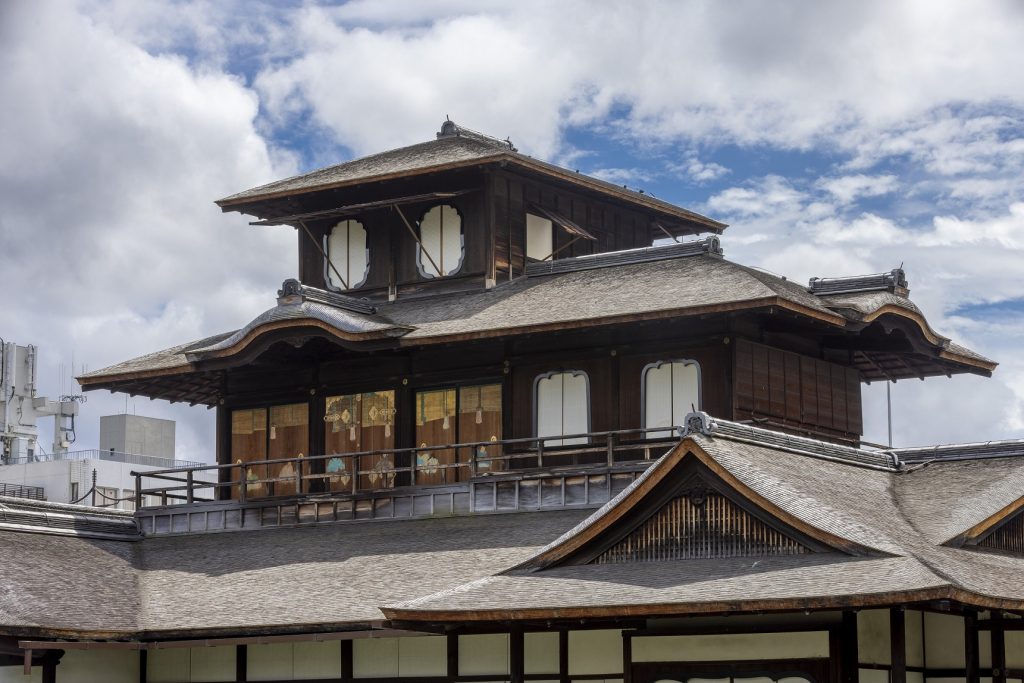
Site du patrimoine mondial
Grâce à son architecture unique et remarquable, le Hiunkaku, qui fait partie du site du patrimoine mondial de Nishi Hongwan-ji, est considéré comme l'un des trois grands pavillons de Kyoto, avec le Kinkaku-ji (le Pavillon d'Or) et le Ginkaku-ji (le Pavillon d'Argent). Son nom, « Hiunkaku », qui signifie « pavillon du nuage volant », provient de son apparence : ses fines colonnes, ses nombreuses portes blanches shoji et sa forme asymétrique, contrairement au Kinkaku-ji et au Ginkaku-ji, lui donnent l'apparence d'un nuage flottant.
| Dates | Du 9 janvier (ven.) au 18 mars (mer.) 2026 *Fermé au public le 31 janvier (sam.), le 2 février (lun.), le 5 février (jeu.), le 7 février (sam.), le 10 février (mar.), le 15 février (dim.), le 16 février (lun.), le 19 février (jeu.), le 22 février (dim.), le 23 février (lun.), le 27 février (ven.), le 3 mars (mar.) – le 7 mars (sam.) et le 10 mars (mar.). |
| Heures | 10h00 – 16h30 (Entrée jusqu'à 16h00) |
| Frais d'admission | Adultes : 800 ¥ / Enfants de 6 à 12 ans : 400 ¥ |
| Accéder | ・Depuis la gare de Kyoto, prenez le bus de ville n° 9, n° 28 ou n° 75 et descendez à Nishi Hongwanji-mae. ・Depuis la porte Hachijo de la gare de Kyoto, prenez le bus Keihan n° 311 ou n° 312 et descendez à Nishi Hongwanji-mae. |
12. Temple Tō-ji, pagode à cinq étages
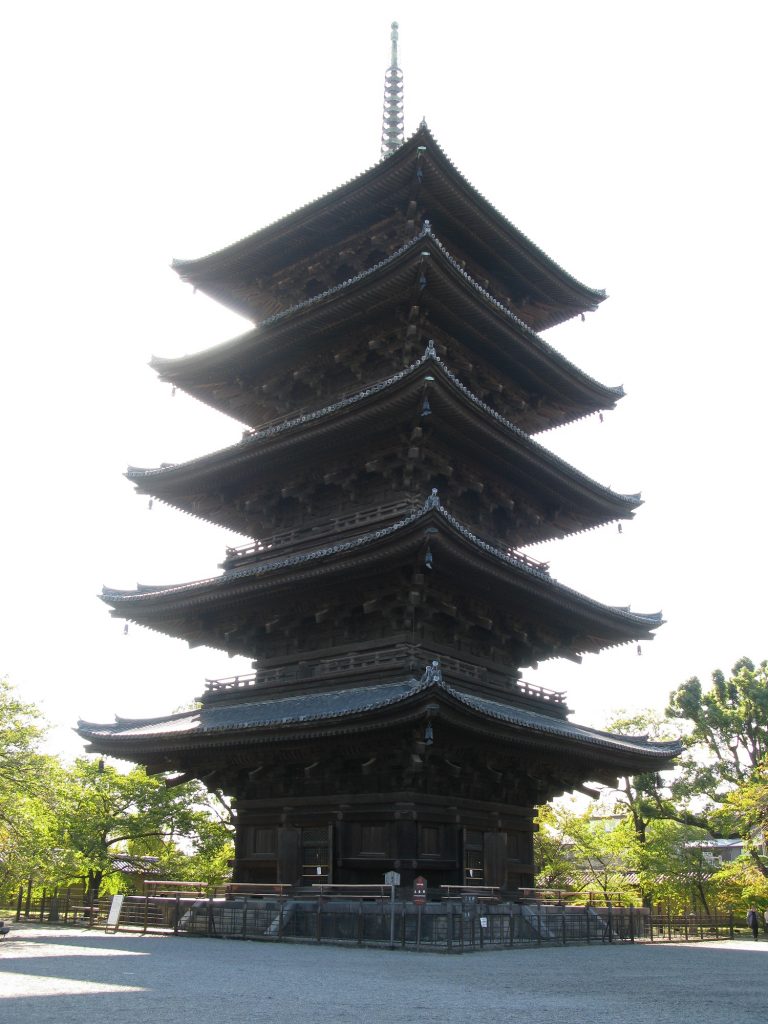
Site du patrimoine mondial
La pagode à cinq étages du Tō-ji est la plus haute tour en bois du Japon, culminant à environ cinquante-cinq mètres au-dessus du sol. À l'occasion des ouvertures spéciales hivernales de Kyoto, les visiteurs peuvent accéder au premier étage de cette pagode, habituellement fermé au public.
À l'intérieur se trouve un pilier qui s'étend jusqu'au cinquième étage, entouré sur quatre côtés par des statues bouddhistes.
| Dates | Du 9 janvier (ven.) au 18 mars (mer.) 2026 |
| Heures | 8h30 – 17h00 (Entrée jusqu'à 16h30) |
| Frais d'admission | Adultes : 1 200 ¥ / 16-18 ans : 700 ¥ / 6-15 ans : 500 ¥ (tarif incluant l’entrée générale) |
| Accéder | • 15 minutes à pied de la gare de Kyoto. • Depuis la gare de Kyoto, prenez le bus urbain n° 205 jusqu'à Toji-michi. 5 minutes à pied de l'arrêt de bus. |
13. Temple Daigo-ji, temple Sanbō-in
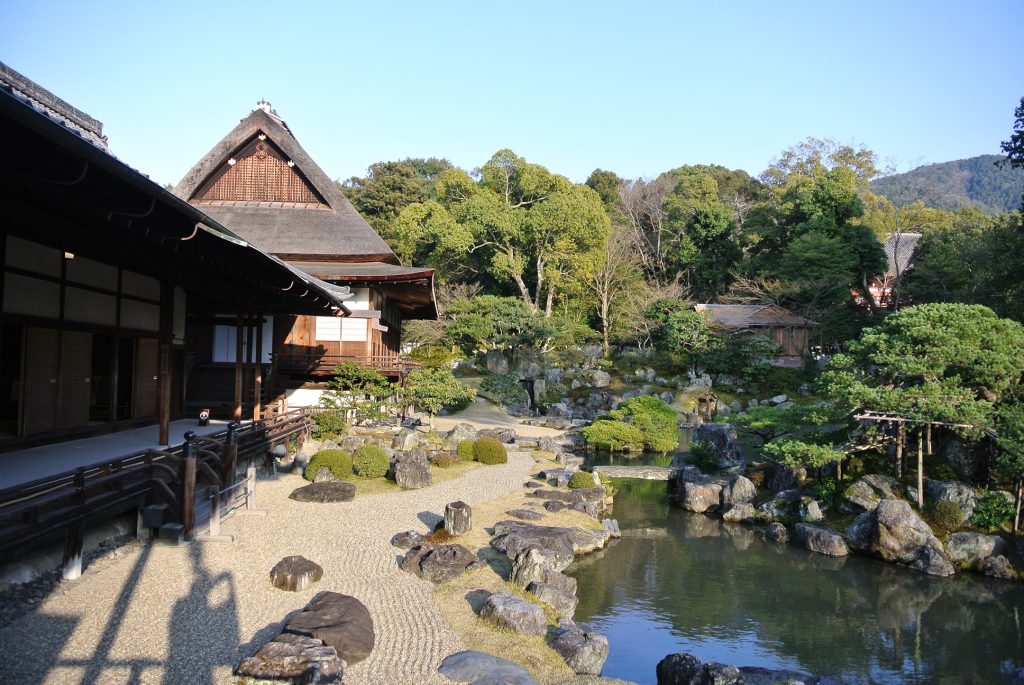
Site du patrimoine mondial
Le bâtiment Omoteshoin, trésor national, et son jardin ont été conçus pour les célèbres rassemblements d'observation des cerisiers en fleurs organisés par Toyotomi Hideyoshi (1537-1598), et la structure est reconnue comme un bel exemple d'architecture somptueuse de la période Momoyama (fin du XVIe siècle).
À l'occasion des ouvertures spéciales d'hiver de Kyoto, le Miroku-Bosatsu (Maitreya Bodhisattva) (Bien culturel important), une statue bouddhiste au visage magnifique créée par le célèbre sculpteur bouddhiste Kaikei, actif au XIIe siècle, ainsi que le salon de thé Chinryu-tei seront ouverts au public.
Vous pouvez également admirer le célèbre bol à thé doré Tenmoku, offert par Hideyoshi.
| Dates | Du 9 janvier (ven.) au 18 mars (mer.) 2026 |
| Heures | 9h00 – 16h30 (Entrée jusqu'à 16h00) de janvier à février, 9h00 – 17h00 (Entrée jusqu’à 16h30) en mars. |
| Frais d'admission | Adultes : 800 ¥ / Gratuit pour les enfants de 6 à 12 ans *Un droit d'entrée général pour Sanbo-in (6 ans et plus : 600 ¥) sera exigé en sus. |
| Accéder | • Depuis la gare JR Yamashina, prenez la ligne Tozai du métro urbain jusqu'à la station Daigo et sortez par la sortie n° 2. 10 minutes à pied depuis la gare. • Depuis la porte Hachijo de la gare de Kyoto (en face de l'hôtel Keihan), prenez la ligne Keihan Bus Kyoto Daigoji jusqu'à Daigoji. |

